The Flames Leave a Feathered Mark
on the Clay Spider
in the Chamber of Ash and Clay
ASU Art Museum, Tempe, Arizona
Curated by Alana Hernández
September 28, 2024 – July 27, 2025
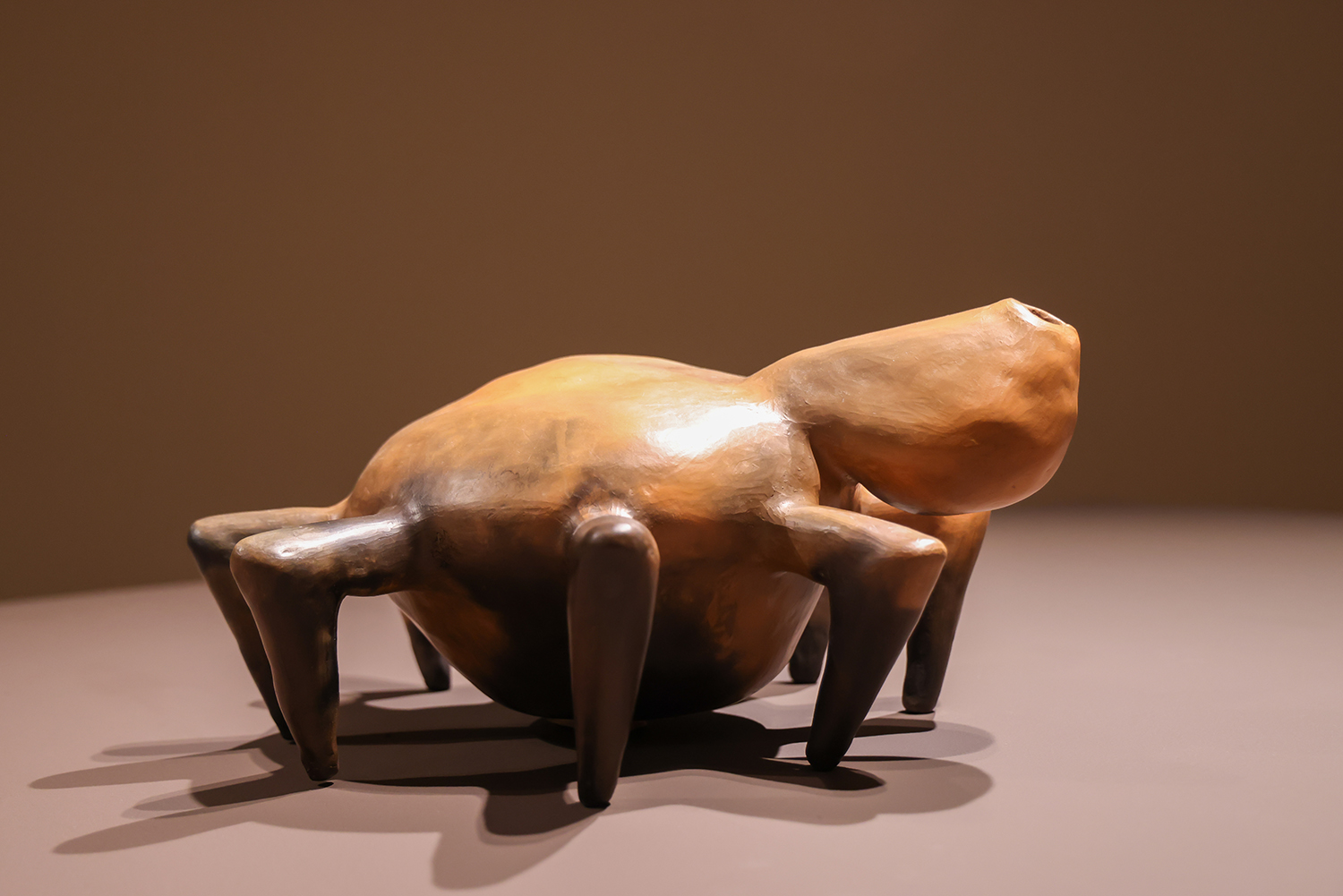
Installation view of “Mariana Castillo Deball: The Flames Leave a Feathered Mark on the Clay Spider in the Chamber of Ash and Clay.”
ASU Art Museum, Tempe, Arizona, September 28, 2024–July 27, 2025.
Organized by ASU Art Museum Senior Curator Alana Hernandez and ASU Art Museum Windgate Curatorial Fellow Sade Moore.
Made possible by generous funding from Windgate Charitable Foundation.
Photograph courtesy of ASU Art Museum © Shaunté Glover.

Installation view of “Mariana Castillo Deball: The Flames Leave a Feathered Mark on the Clay Spider in the Chamber of Ash and Clay.”
ASU Art Museum, Tempe, Arizona, September 28, 2024–July 27, 2025.
Organized by ASU Art Museum Senior Curator Alana Hernandez and ASU Art Museum Windgate Curatorial Fellow Sade Moore.
Made possible by generous funding from Windgate Charitable Foundation.
Photograph courtesy of ASU Art Museum © Shaunté Glover.
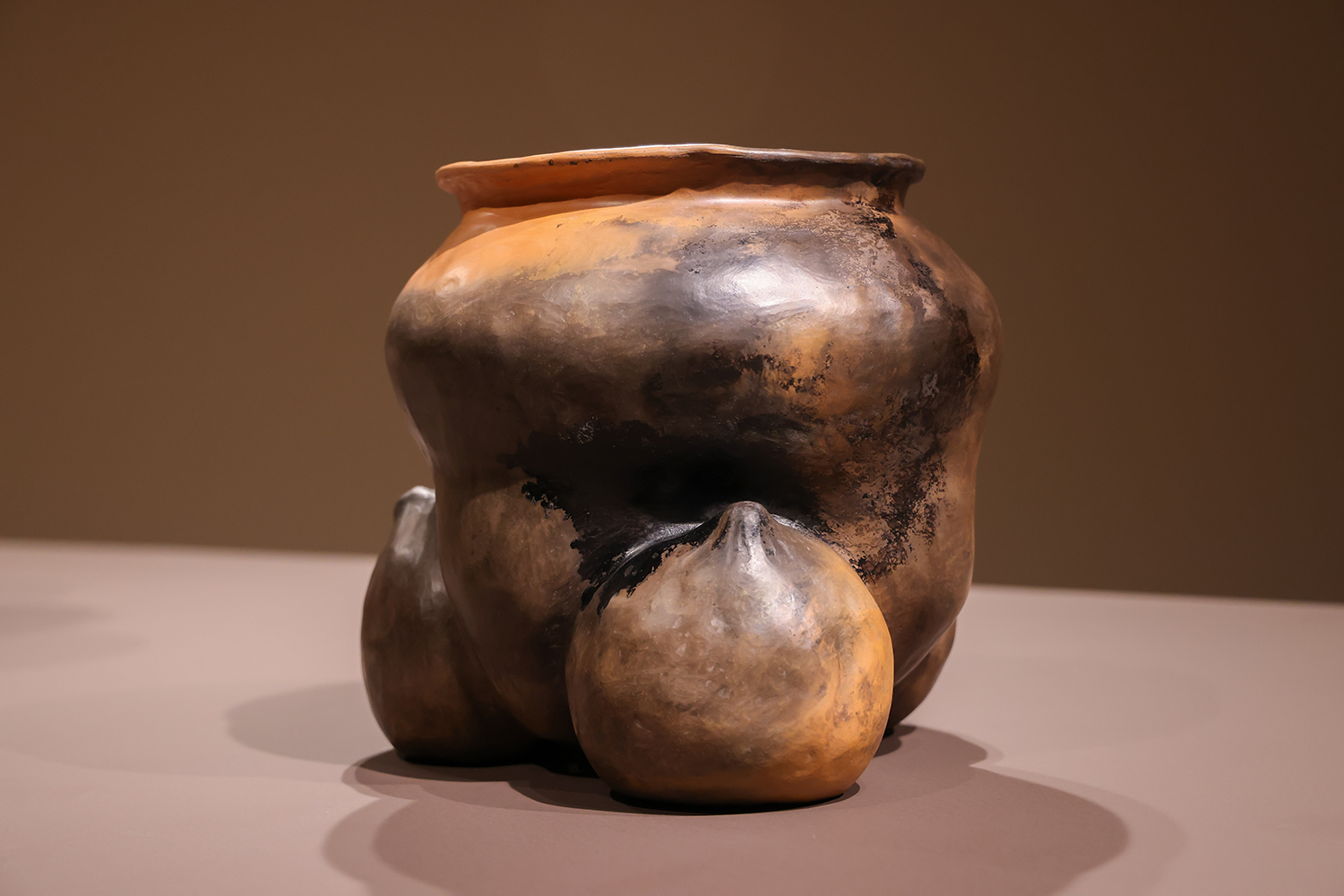
Installation view of “Mariana Castillo Deball: The Flames Leave a Feathered Mark on the Clay Spider in the Chamber of Ash and Clay.”
ASU Art Museum, Tempe, Arizona, September 28, 2024–July 27, 2025.
Organized by ASU Art Museum Senior Curator Alana Hernandez and ASU Art Museum Windgate Curatorial Fellow Sade Moore.
Made possible by generous funding from Windgate Charitable Foundation.
Photograph courtesy of ASU Art Museum © Shaunté Glover.
What do you think everyday objects tell us about history and ourselves? What might future archaeologists think about our commonplace items? What might they be able to understand about our current moment and our social and cultural backgrounds?
“The Flames Leave a Feathered Mark on the Clay Spider in the Chamber of Ash and Clay” marks the first solo museum presentation for internationally celebrated Mexican artist Mariana Castillo Deball (Germany, b. Mexico 1975) in Arizona. The exhibition features a newly commissioned installation of seven hand-built, pit-fired stoneware ceramics resembling natural and manufactured items –– from spiders and turtles to altars and backpacks. It also features a “Cabeza Olmeca San Lorenzo 1 (rostro lado derecho),” a fiberglass sculpture of half of an Olmec head, by Castillo Deball, which has been acquired as part of the museum’s collection. Taken as a whole, Castillo Deball’s work, bridging science, archaeology and craft, questions how objects shape versions of identities and histories in our contemporary world.
“Mariana Castillo Deball: The Flames Leave a Feathered Mark on the Clay Spider in the Chamber of Ash and Clay” is organized by ASU Art Museum Senior Curator Alana Hernandez and ASU Art Museum Windgate Curatorial Fellow Sade Moore and made possible by generous funding from Windgate Charitable Foundation.

Installation view of “Mariana Castillo Deball: The Flames Leave a Feathered Mark on the Clay Spider in the Chamber of Ash and Clay.”
ASU Art Museum, Tempe, Arizona, September 28, 2024–July 27, 2025.
Organized by ASU Art Museum Senior Curator Alana Hernandez and ASU Art Museum Windgate Curatorial Fellow Sade Moore.
Made possible by generous funding from Windgate Charitable Foundation.
Photograph courtesy of ASU Art Museum © Shaunté Glover.

Installation view of “Mariana Castillo Deball: The Flames Leave a Feathered Mark on the Clay Spider in the Chamber of Ash and Clay.”
ASU Art Museum, Tempe, Arizona, September 28, 2024–July 27, 2025.
Organized by ASU Art Museum Senior Curator Alana Hernandez and ASU Art Museum Windgate Curatorial Fellow Sade Moore.
Made possible by generous funding from Windgate Charitable Foundation.
Photograph courtesy of ASU Art Museum © Shaunté Glover.


Installation view of “Mariana Castillo Deball: The Flames Leave a Feathered Mark on the Clay Spider in the Chamber of Ash and Clay.”
ASU Art Museum, Tempe, Arizona, September 28, 2024–July 27, 2025.
Organized by ASU Art Museum Senior Curator Alana Hernandez and ASU Art Museum Windgate Curatorial Fellow Sade Moore.
Made possible by generous funding from Windgate Charitable Foundation.
Photograph courtesy of ASU Art Museum © Shaunté Glover.
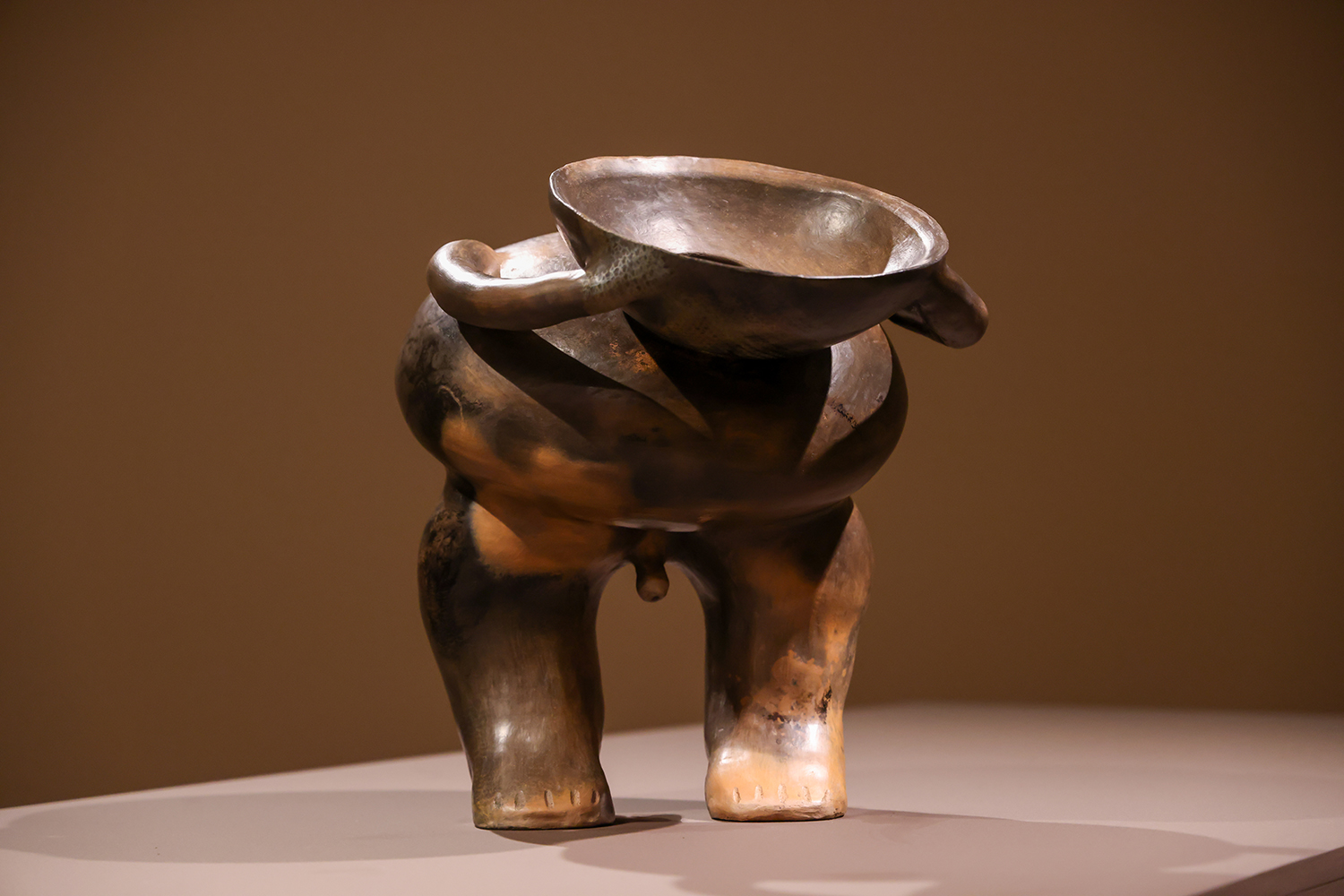
Installation view of “Mariana Castillo Deball: The Flames Leave a Feathered Mark on the Clay Spider in the Chamber of Ash and Clay.”
ASU Art Museum, Tempe, Arizona, September 28, 2024–July 27, 2025.
Organized by ASU Art Museum Senior Curator Alana Hernandez and ASU Art Museum Windgate Curatorial Fellow Sade Moore.
Made possible by generous funding from Windgate Charitable Foundation.
Photograph courtesy of ASU Art Museum © Shaunté Glover.
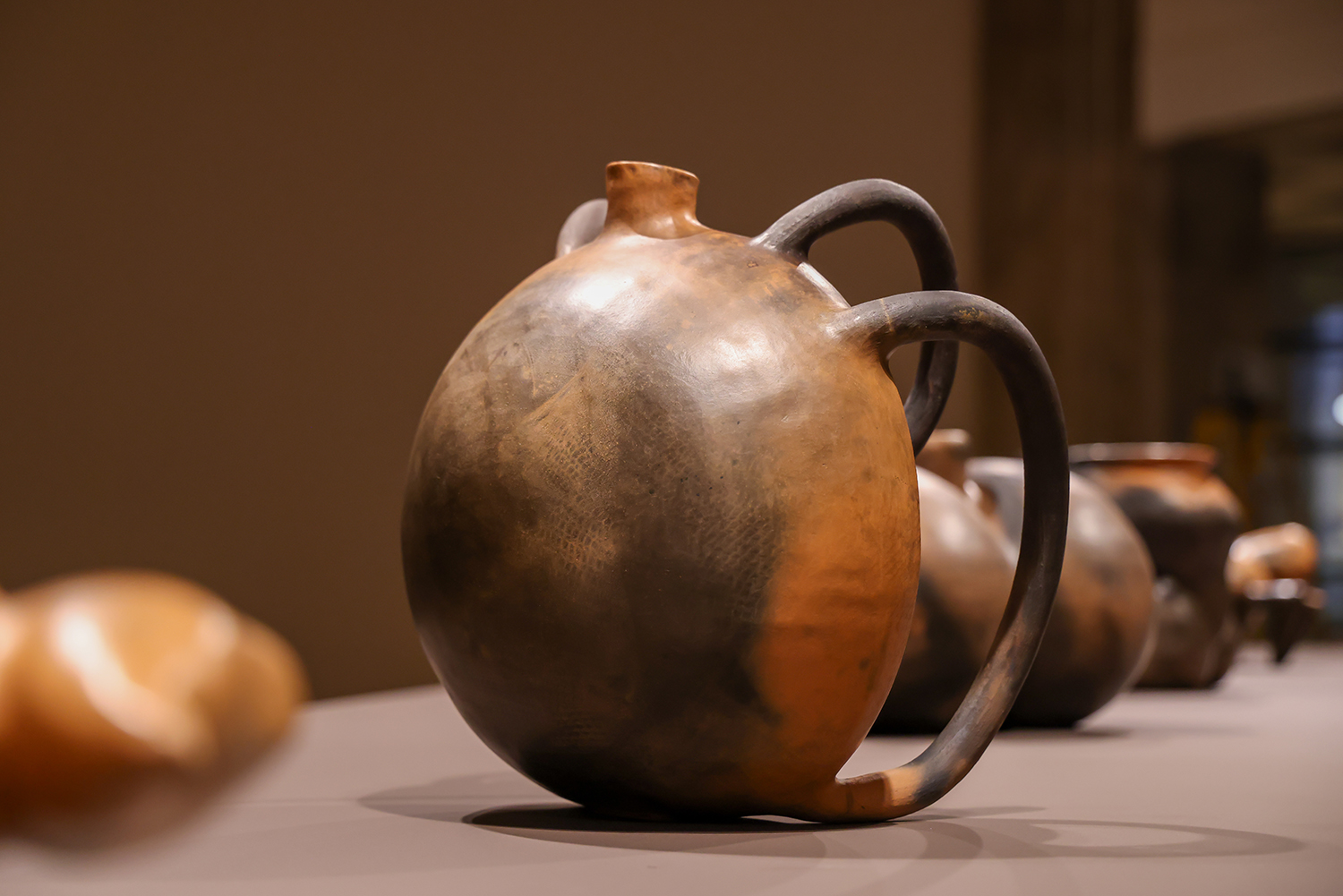
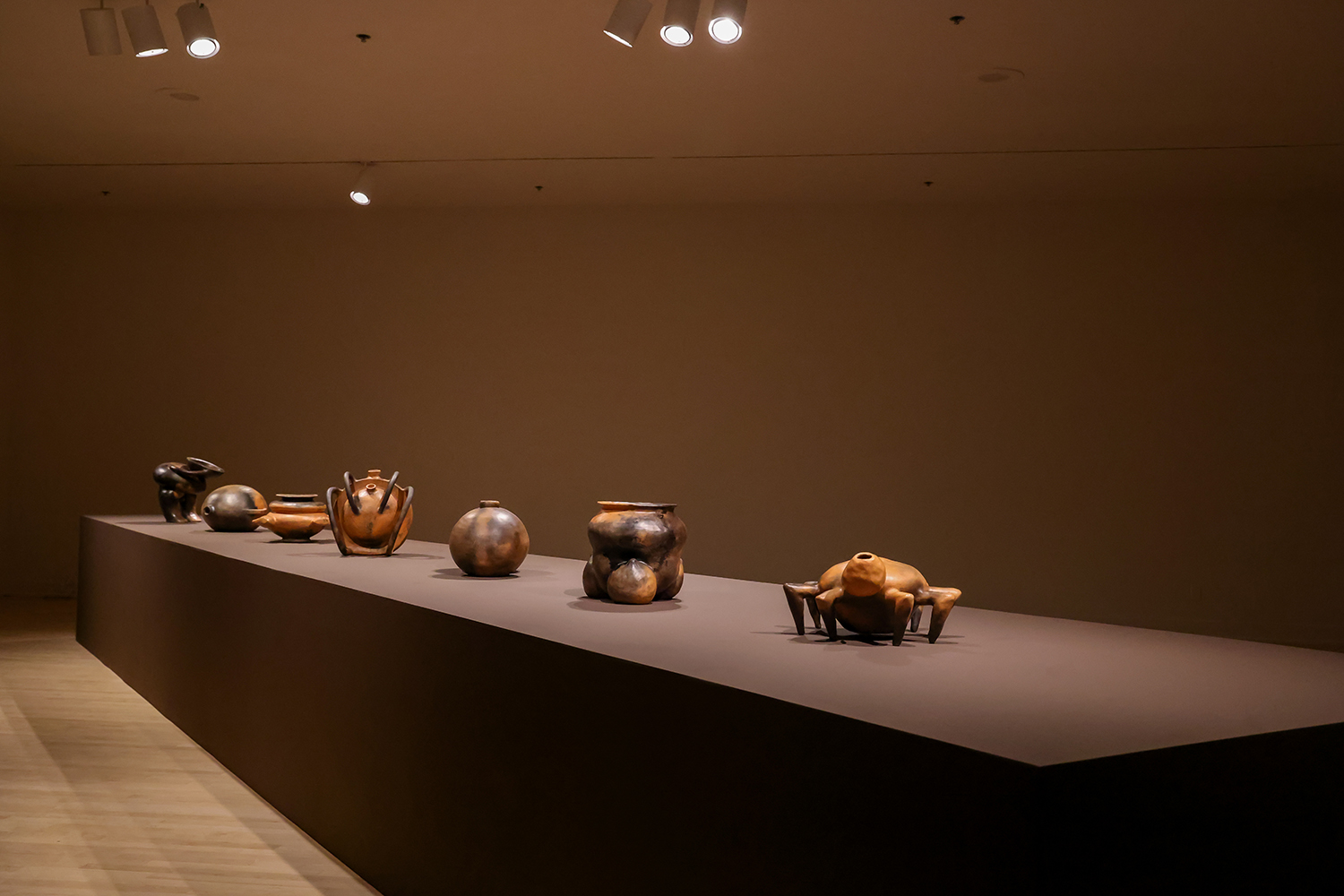
Installation view of “Mariana Castillo Deball: The Flames Leave a Feathered Mark on the Clay Spider in the Chamber of Ash and Clay.”
ASU Art Museum, Tempe, Arizona, September 28, 2024–July 27, 2025.
Organized by ASU Art Museum Senior Curator Alana Hernandez and ASU Art Museum Windgate Curatorial Fellow Sade Moore.
Made possible by generous funding from Windgate Charitable Foundation.
Photograph courtesy of ASU Art Museum © Shaunté Glover.
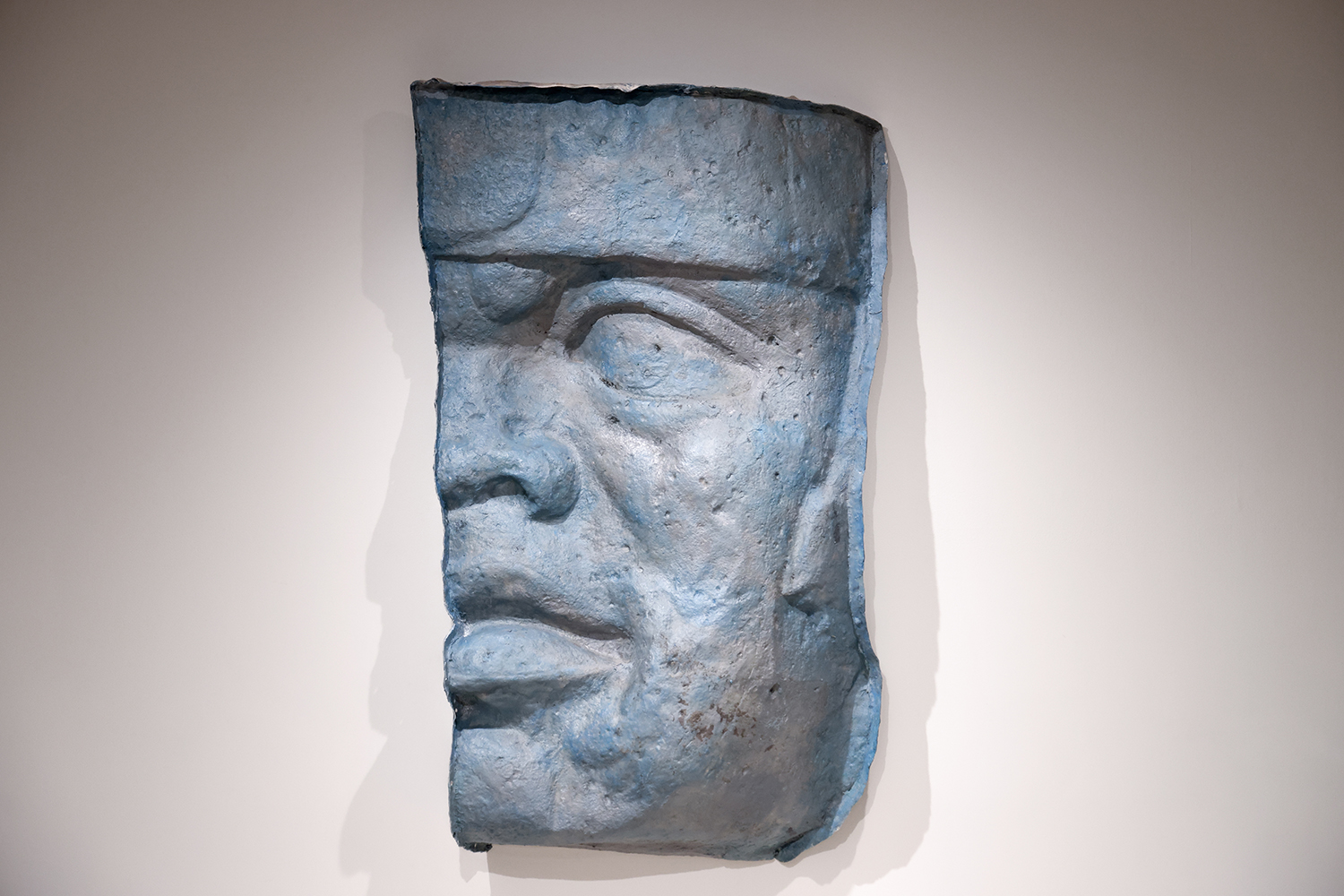
Installation view of “Mariana Castillo Deball: The Flames Leave a Feathered Mark on the Clay Spider in the Chamber of Ash and Clay.”
ASU Art Museum, Tempe, Arizona, September 28, 2024–July 27, 2025.
Organized by ASU Art Museum Senior Curator Alana Hernandez and ASU Art Museum Windgate Curatorial Fellow Sade Moore.
Made possible by generous funding from Windgate Charitable Foundation.
Photograph courtesy of ASU Art Museum © Shaunté Glover.
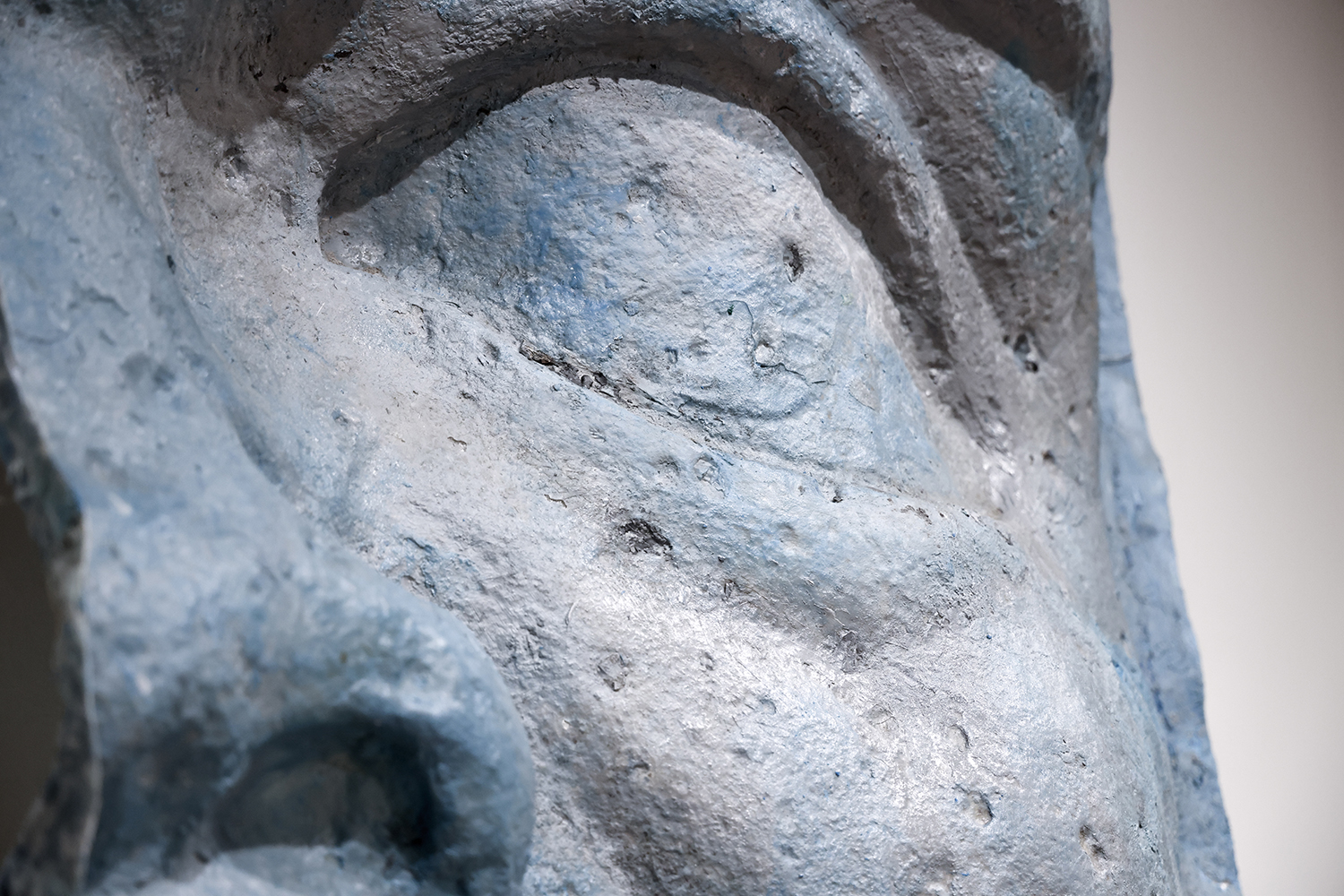
Installation view of “Mariana Castillo Deball: The Flames Leave a Feathered Mark on the Clay Spider in the Chamber of Ash and Clay.”
ASU Art Museum, Tempe, Arizona, September 28, 2024–July 27, 2025.
Organized by ASU Art Museum Senior Curator Alana Hernandez and ASU Art Museum Windgate Curatorial Fellow Sade Moore.
Made possible by generous funding from Windgate Charitable Foundation.
Photograph courtesy of ASU Art Museum © Shaunté Glover.
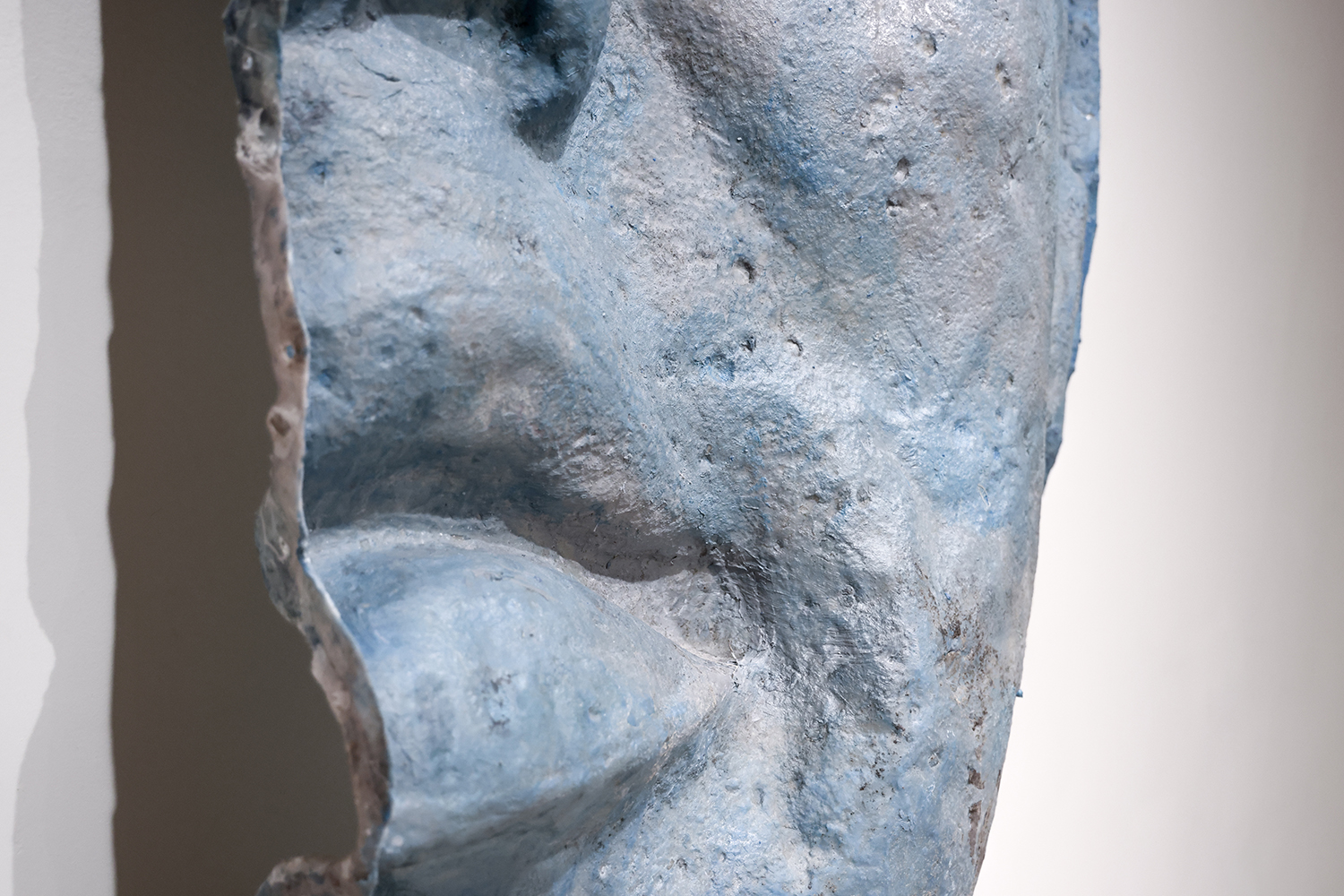
Installation view of “Mariana Castillo Deball: The Flames Leave a Feathered Mark on the Clay Spider in the Chamber of Ash and Clay.”
ASU Art Museum, Tempe, Arizona, September 28, 2024–July 27, 2025.
Organized by ASU Art Museum Senior Curator Alana Hernandez and ASU Art Museum Windgate Curatorial Fellow Sade Moore.
Made possible by generous funding from Windgate Charitable Foundation.
Photograph courtesy of ASU Art Museum © Shaunté Glover.
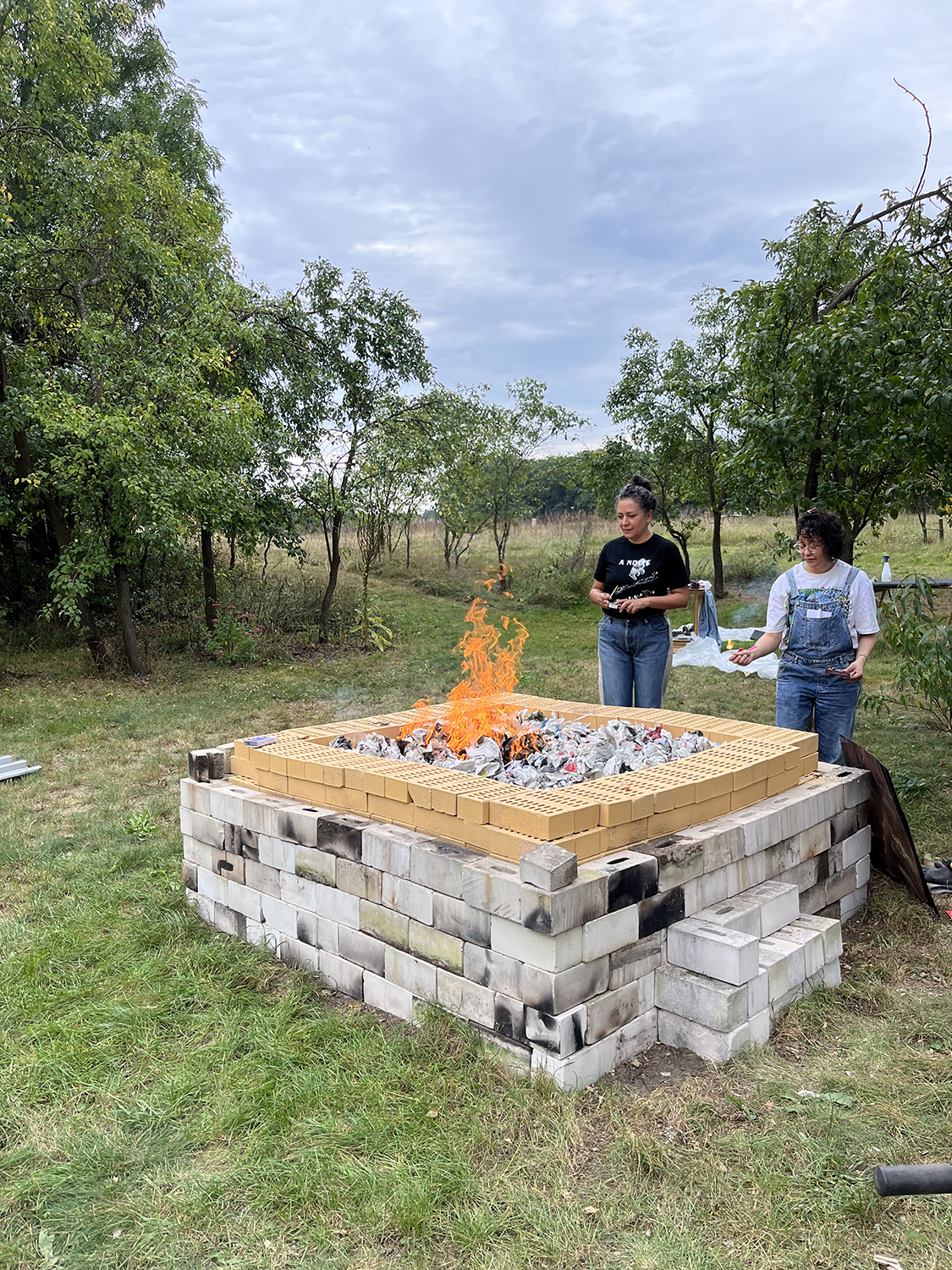
Installation view of “Mariana Castillo Deball: The Flames Leave a Feathered Mark on the Clay Spider in the Chamber of Ash and Clay.”
ASU Art Museum, Tempe, Arizona, September 28, 2024–July 27, 2025.
Organized by ASU Art Museum Senior Curator Alana Hernandez and ASU Art Museum Windgate Curatorial Fellow Sade Moore.
Made possible by generous funding from Windgate Charitable Foundation.
Photograph courtesy of ASU Art Museum © Shaunté Glover.
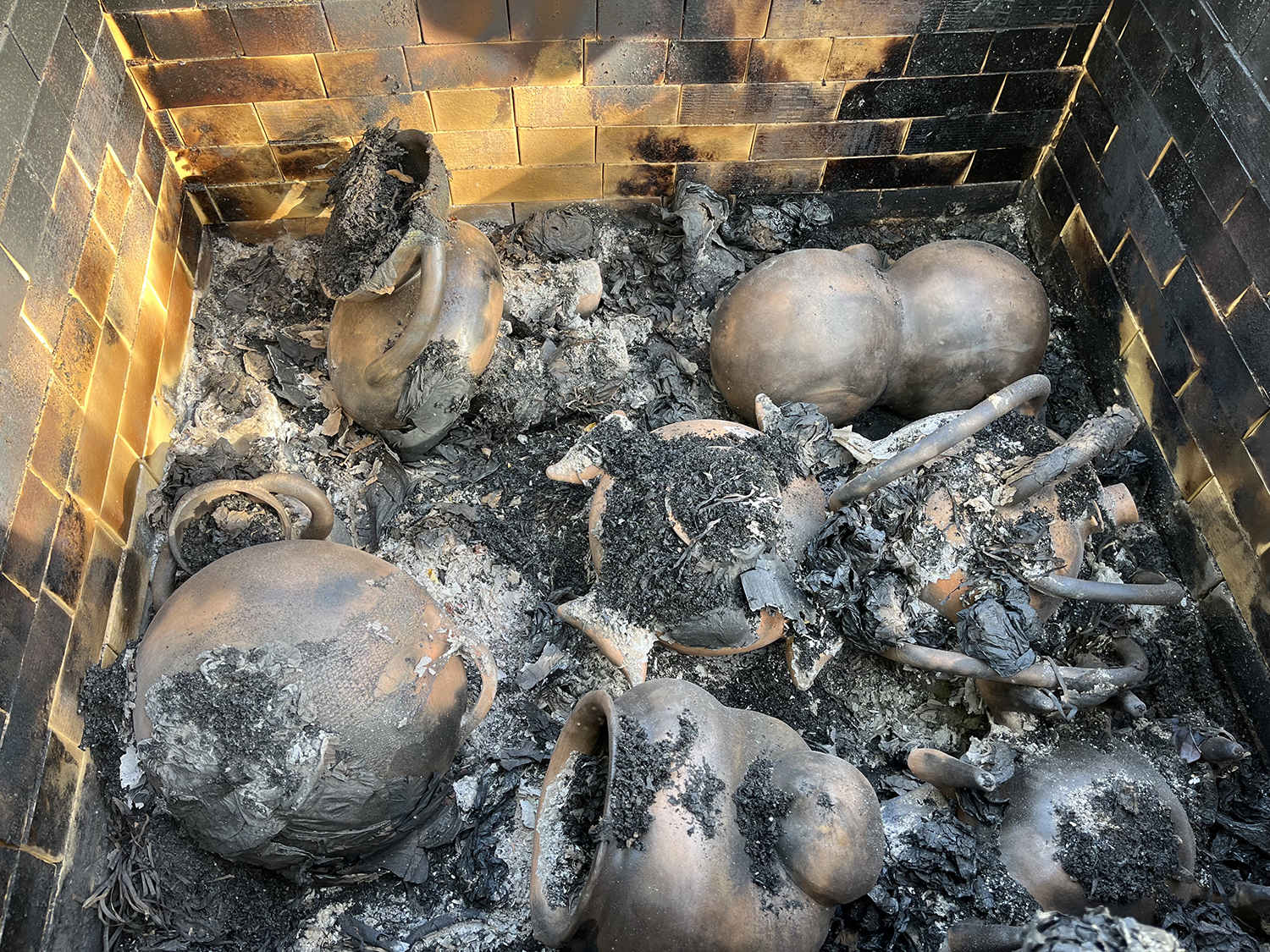
Installation view of “Mariana Castillo Deball: The Flames Leave a Feathered Mark on the Clay Spider in the Chamber of Ash and Clay.”
ASU Art Museum, Tempe, Arizona, September 28, 2024–July 27, 2025.
Organized by ASU Art Museum Senior Curator Alana Hernandez and ASU Art Museum Windgate Curatorial Fellow Sade Moore.
Made possible by generous funding from Windgate Charitable Foundation.
Photograph courtesy of ASU Art Museum © Shaunté Glover.
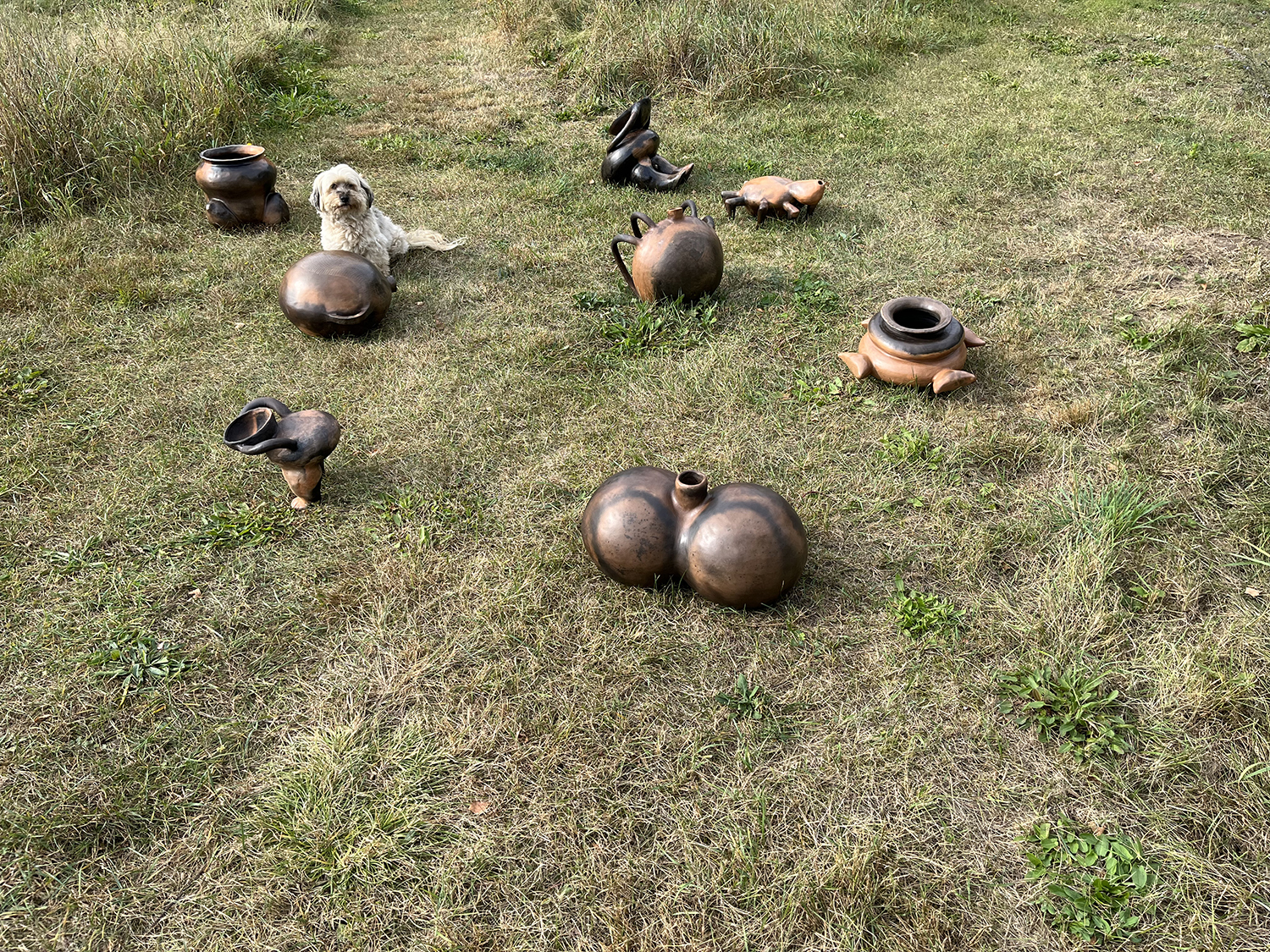
In a Convex Mirror
Pink Summer Contemporary Art
December 2, 2022
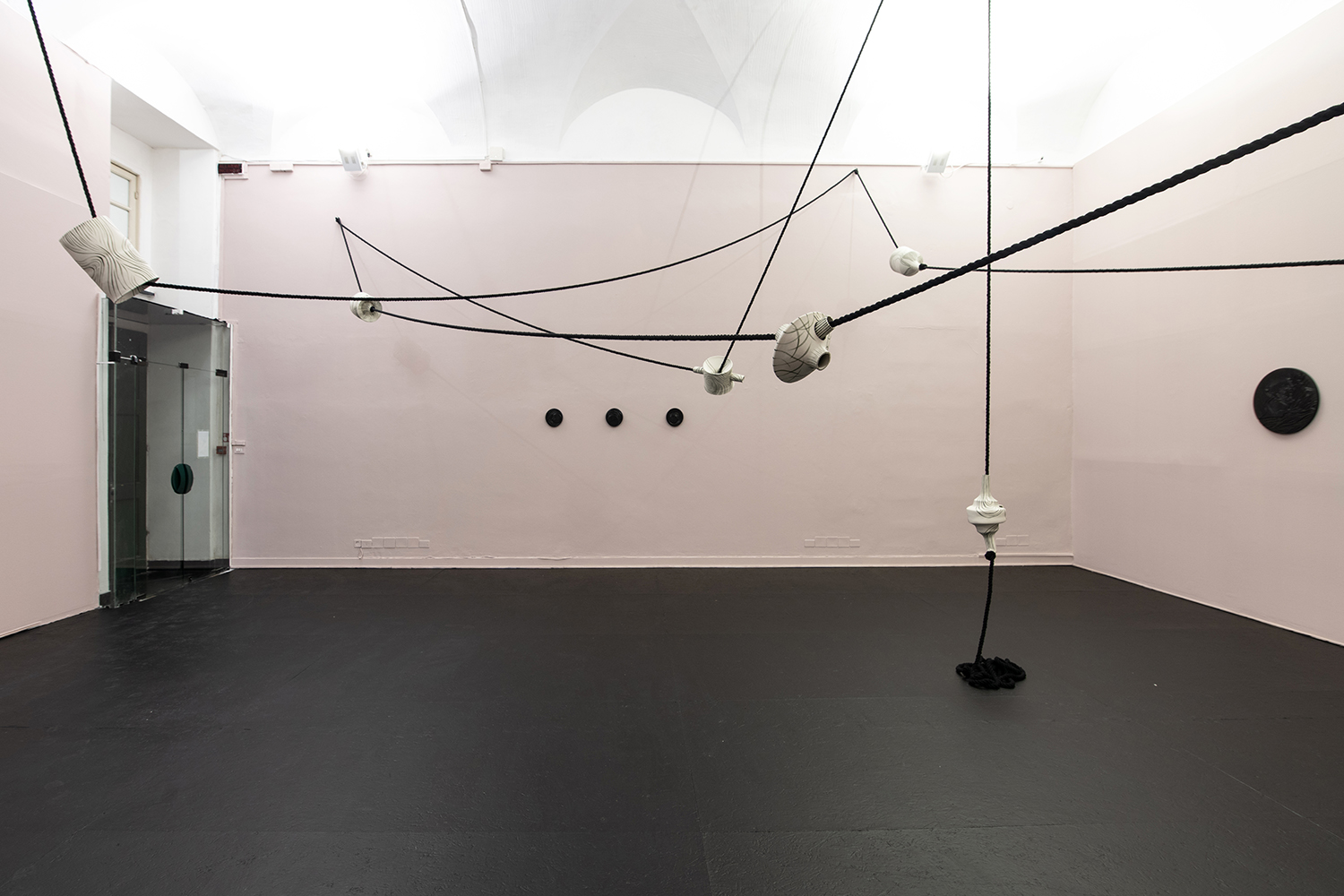
Mariana Castillo Deball, Exhibition of In a Convex Mirror, 2022, Pink Summer Contemporary Art, Genoa, Italy
Photo: Alice Moschin
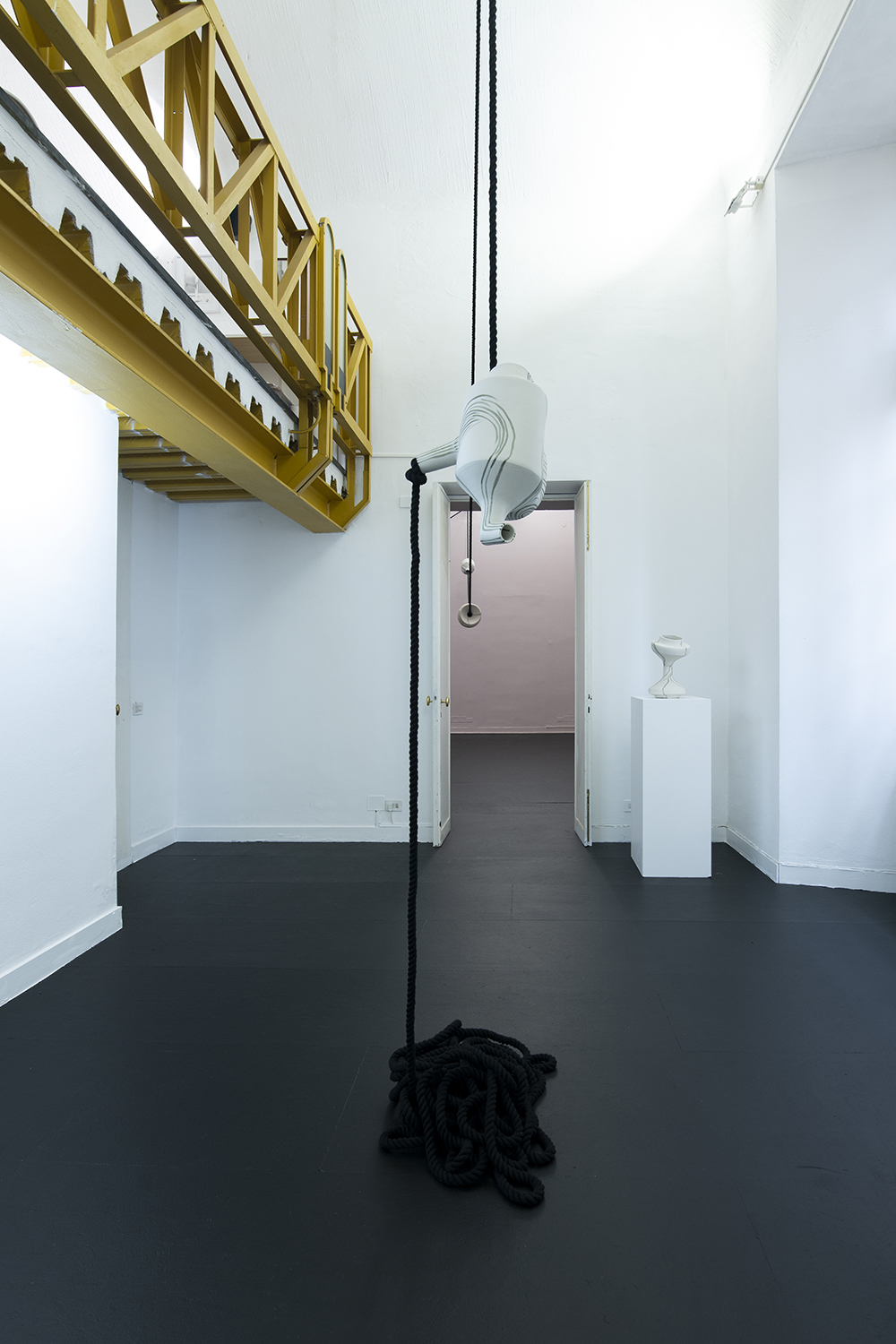
Mariana Castillo Deball, Exhibition of In a Convex Mirror, 2022, Pink Summer Contemporary Art, Genoa, Italy
Photo: Alice Moschin
The title of the exhibition comes from the poem by John Ashbery: Self-portrait in a convex Mirror from 1974, in which he takes as a starting point the homogonous painting by the Italian late Renaissance artist Parmigianino from c. 1524. The painting is a Self-portrait of his image in a convex mirror.
Parmigianino used a half spherical wooden surface for the painting, replicating the distortion of the convex mirror on the painted shape.
The whole is instable within
Instability, a globe like ours, resting
On a pedestal of vacuum, a ping-pong ball
Secure on its jet of water.
And just as there are no words for the surface, that is
No words to say what it really is, that it is not
Superficial but a visible core, then there is
No way out of the problem of pathos vs. experience.
Mariana Castillo Deball’s anthropological gaze is focused on work, on matter, on nature, the places of choice for her research are anthropology, archaeology, paleontology, museums and collections of applied arts and those of science, wherever objects can be found, tools that are the result of craft and traditional production processes that incorporate technical knowledge of collective cooperation, objects with which the artist interacts, adopting, adapting, translating and appropriating them to tell a relativized story while reforming the Eurocentrism of History. Mariana Castillo Deball liberates the intangible essence of objects by freeing them both from their use and exchange value for which they were made in their communities of origin, and from the positivist classification of museums or collections in general, redesigning spaces. Castillo Deball well knows that putting or putting things back to their place confirms the social and cultural order established; so, she moves things as far away from their agreed places as possible. Liberating objects by turning them into things is a ritual practice of Castillo Deball’s art to free the thought, to make it breathe and have a more natural relationship with the surrounding world. Mariana Castillo Deball’s work by reasoning and deliberating about things, represents a curious or rather surreal study of material culture, since objects inform our lives, our politics and indications of gender. Castillo Deball’s work with practical reasoning also focuses on waste. Someone said that man is a ravenous being even of future hungers, which have put and continue to seriously endanger the ecological life of our planet Earth. What the past and the present have in common regarding material culture is the disposal of objects once they are no longer used, but unlike the present, in the past there was a scarcity of objects that moreover were organic, and the death of an object coincided with its inability to be repaired once broken: the value was saving not consumption. Today the death of an object often occurs long before its irreparability, and our civilization is based on the consumption of not only having but also being.
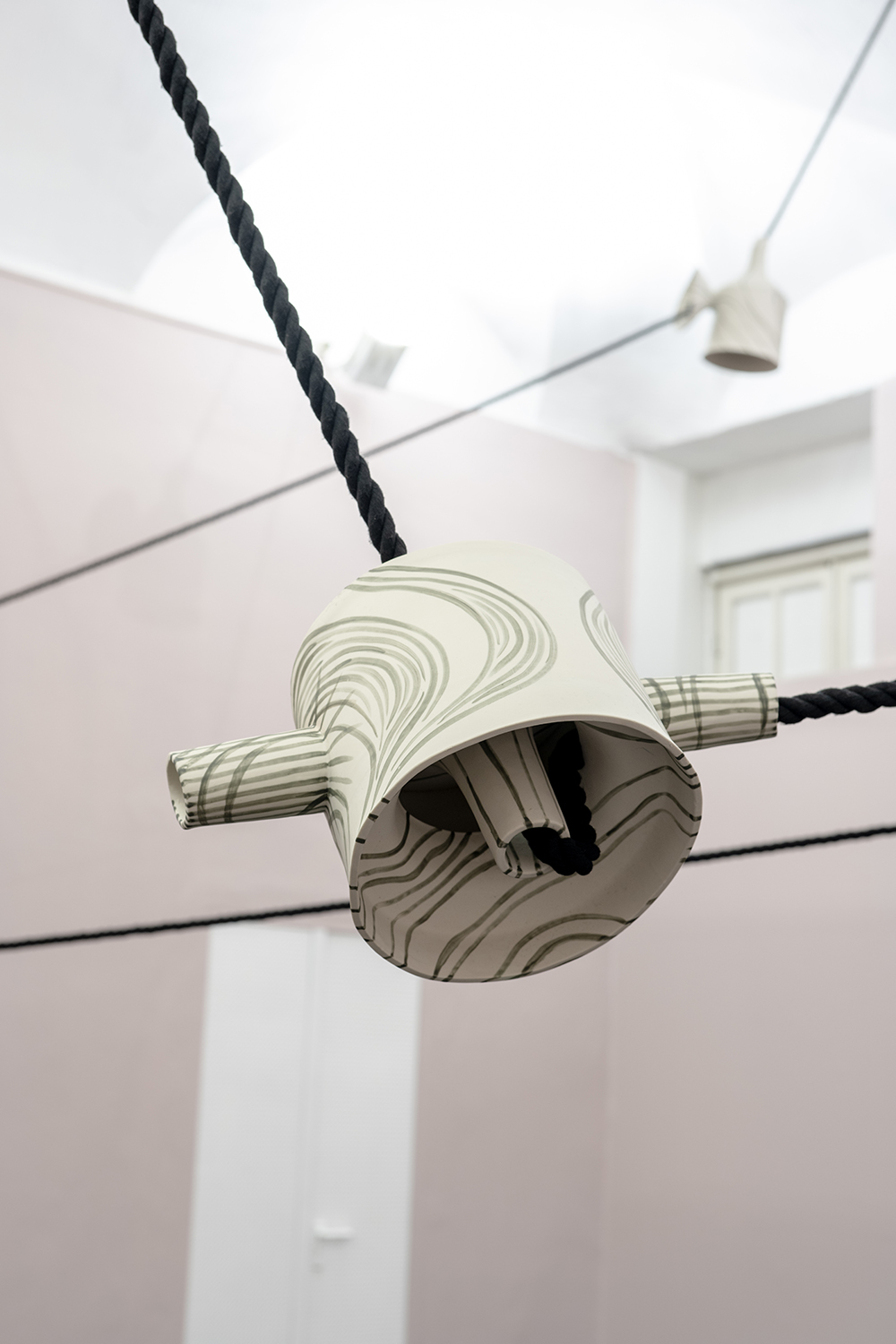
Mariana Castillo Deball, In a Convex Mirror #6, 2022, ceramic vessel made of porcelain with engobe slip and hung with black cotton rope, Installation view in the exhibition In a Convex Mirror, 2022, Pink Summer Contemporary Art, Genoa, Italy
Photo: Alice Moschin
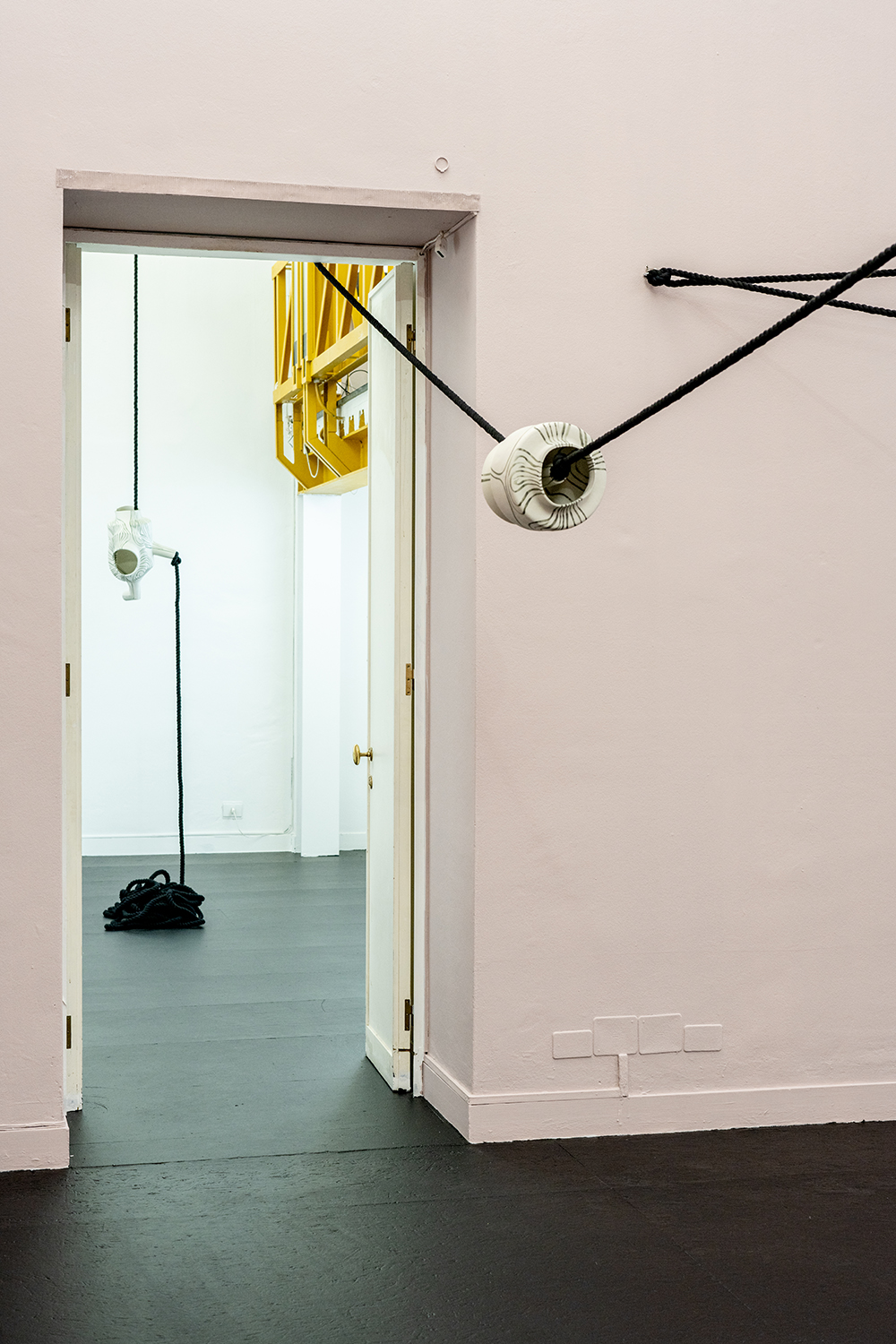
Mariana Castillo Deball, Exhibition of In a Convex Mirror, 2022, Pink Summer Contemporary Art, Genoa, Italy
Photo: Alice Moschin

Mariana Castillo Deball, In a Convex Mirror #10, 2022, ceramic vessel made of porcelain with engobe slip and hung with black cotton rope, 32 x 26 x 26cm, Installation view in the exhibition In a Convex Mirror, 2022, Pink Summer Contemporary Art, Genoa, Italy
Photo: Alice Moschin
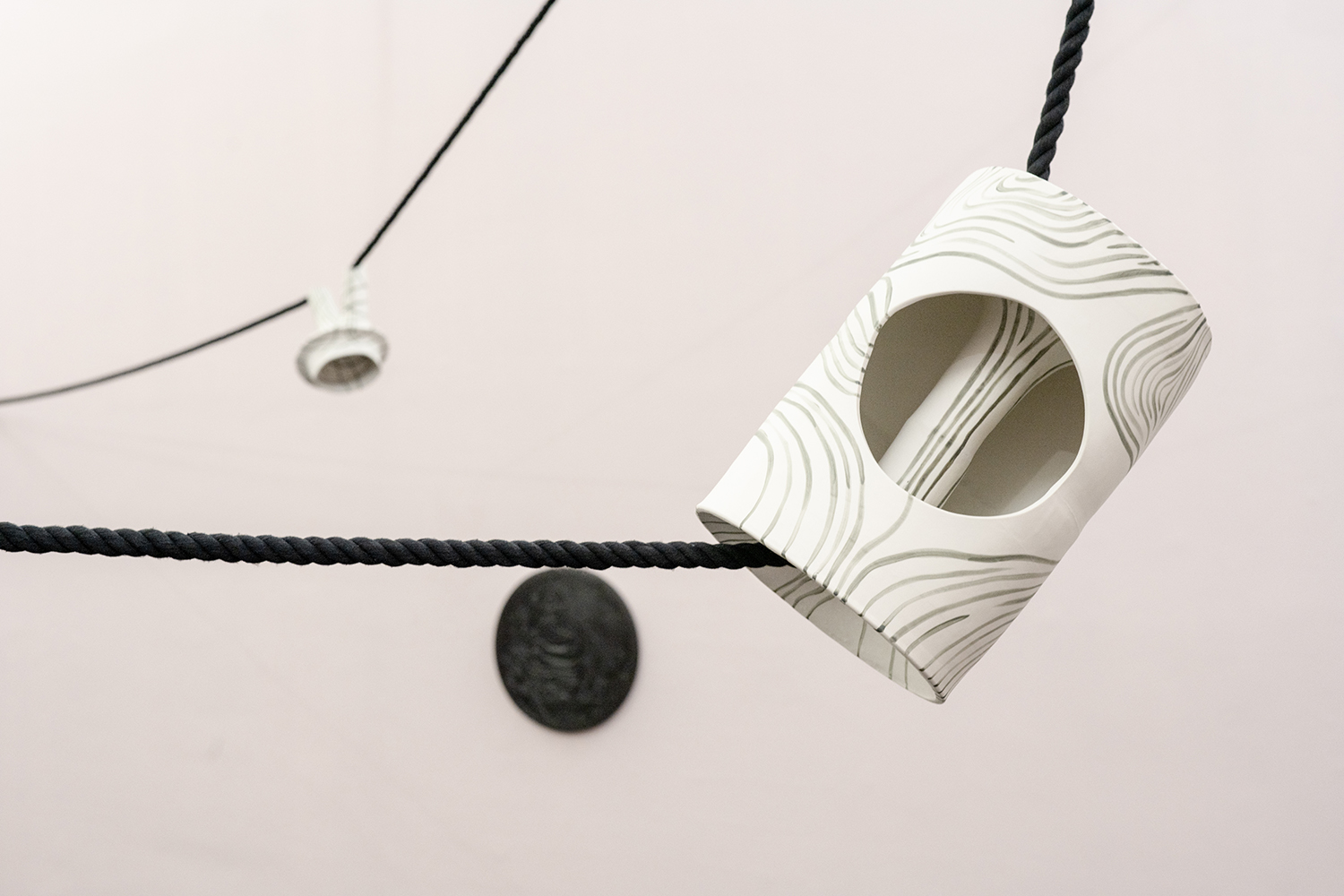
Mariana Castillo Deball, In a Convex Mirror #9, 2022, ceramic vessel made of porcelain with engobe slip and hung with black cotton rope, 35 x 24 x 25 cm, Installation view in the exhibition In a Convex Mirror, 2022, Pink Summer Contemporary Art, Genoa, Italy
Photo: Alice Moschin
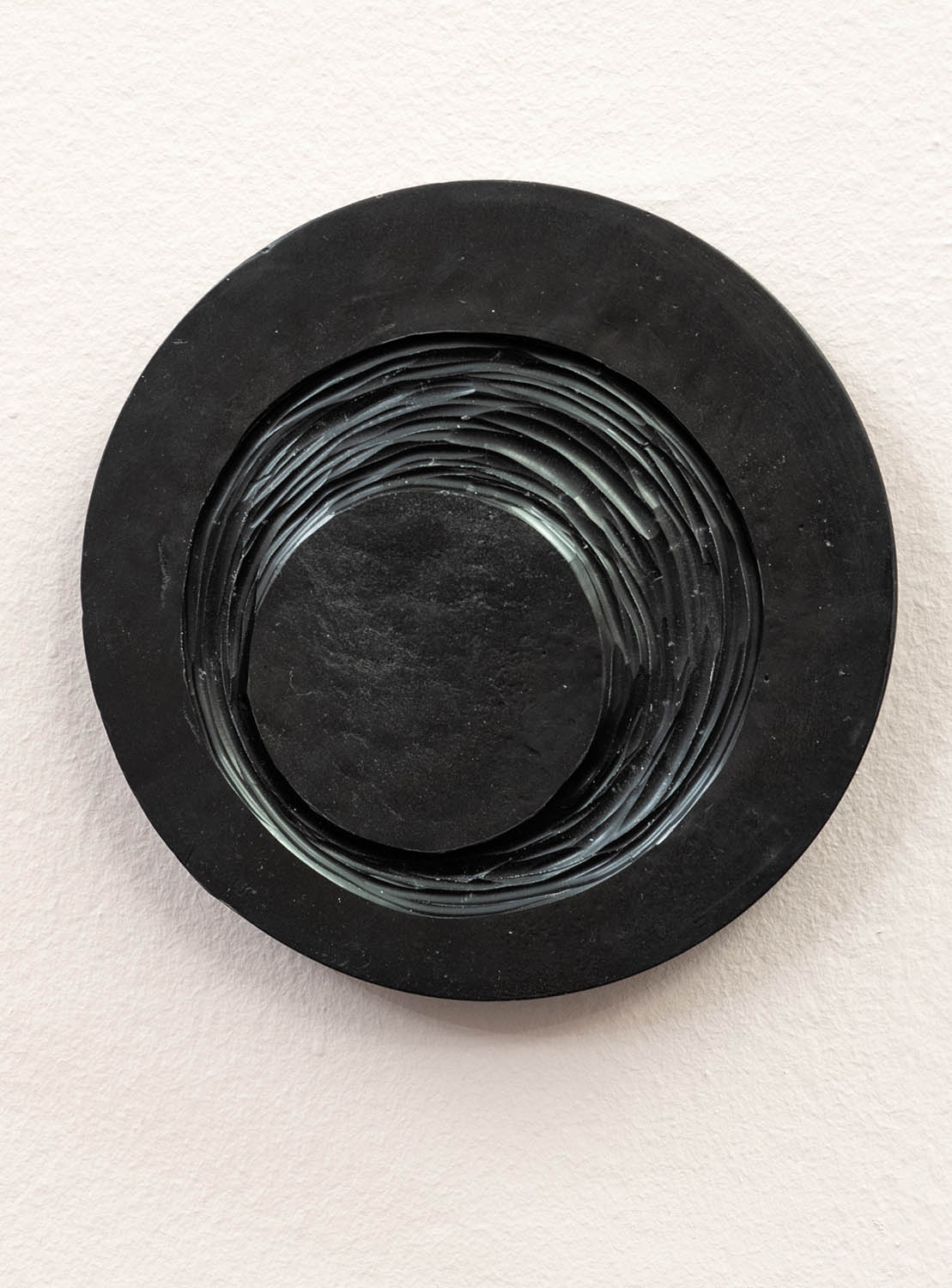
Mariana Castillo Deball, The whole is unstable within, 2022, wax circle with black pigment and carved drawing Ø 30 cm, Installation view in the exhibition In a Convex Mirror, 2022, Pink Summer Contemporary Art, Genoa, Italy
Photo: Alice Moschin
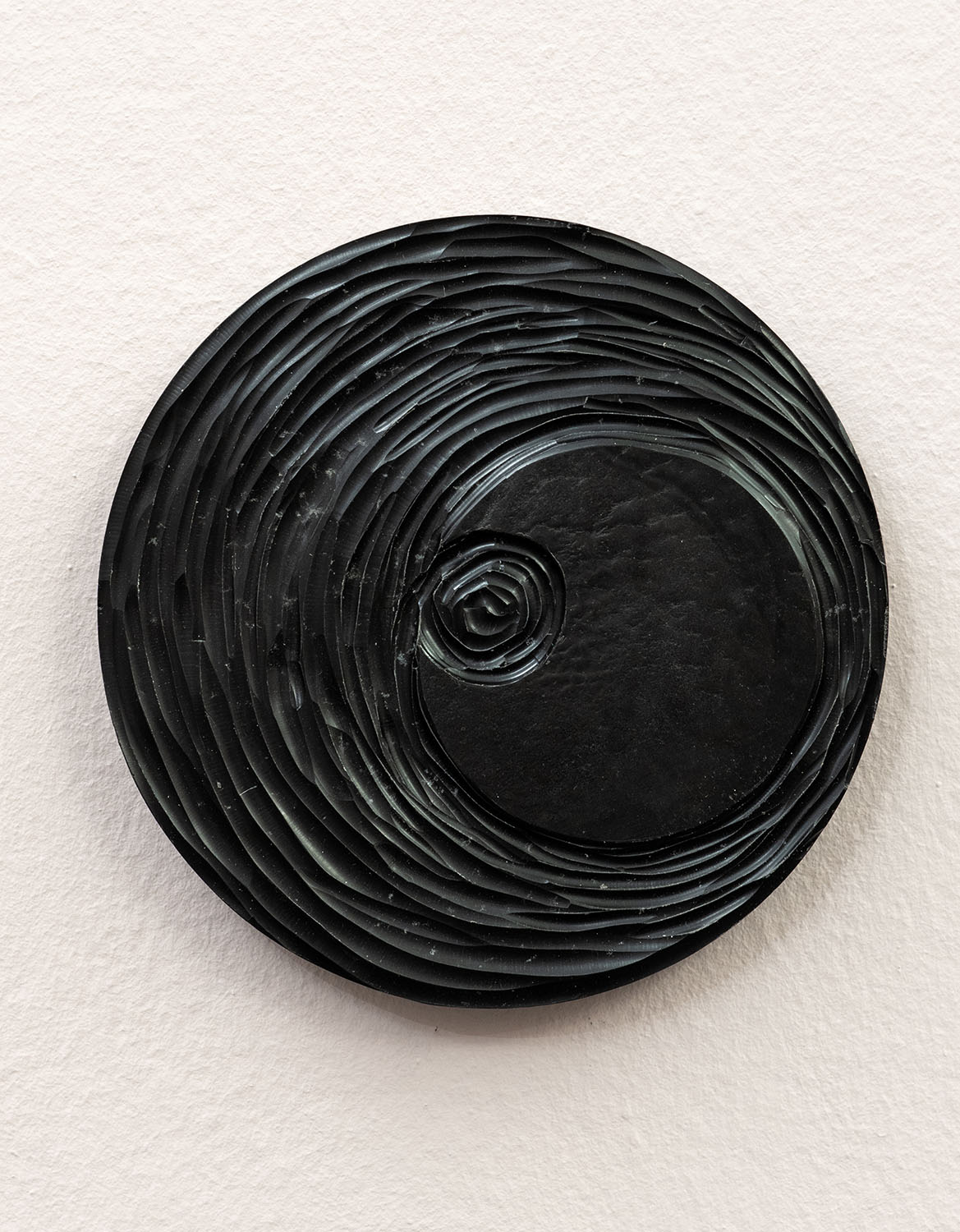
Mariana Castillo Deball, A ping-pong ball, 2022, wax circle with black pigment and carved drawing Ø 20 cm, Installation view in the exhibition In a Convex Mirror, 2022, Pink Summer Contemporary Art, Genoa, Italy
Photo: Alice Moschin
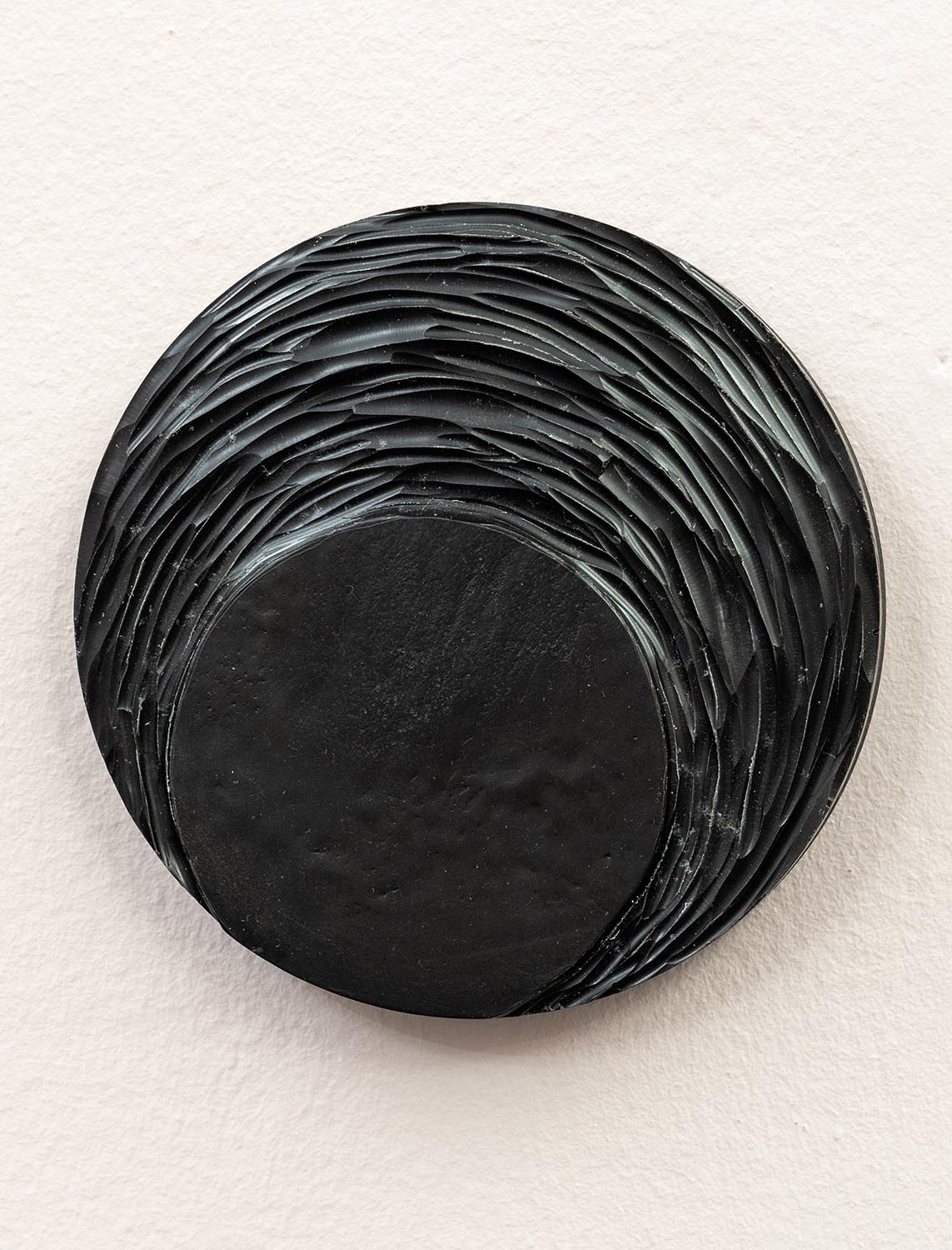
Mariana Castillo Deball, On a pedestal of vacuum, 2022, wax circle with black pigment and carved drawing Ø 20 cm, Installation view in the exhibition In a Convex Mirror, 2022, Pink Summer Contemporary Art, Genoa, Italy
Photo: Alice Moschin
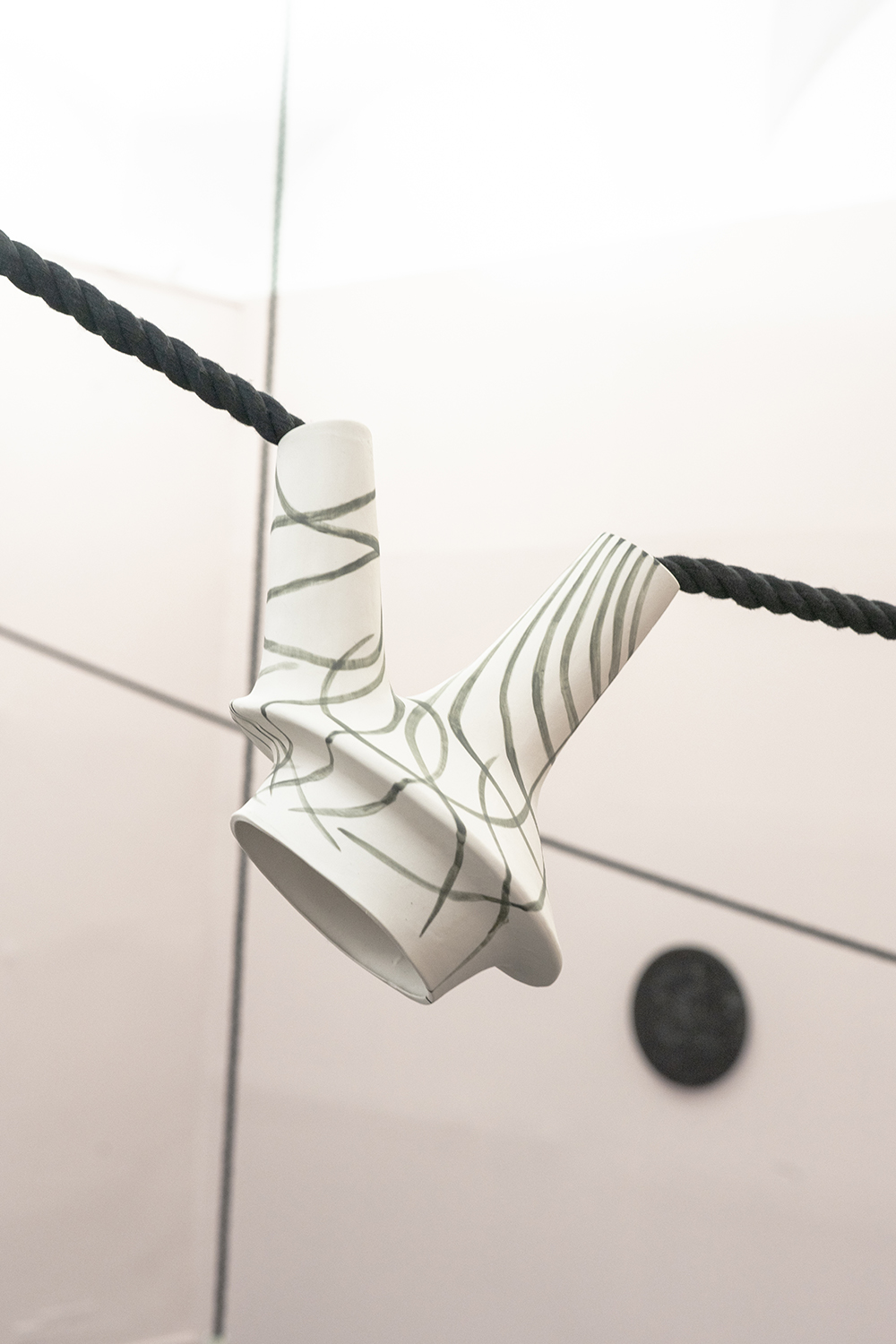
Mariana Castillo Deball, In a Convex Mirror #1, 2022, ceramic vessel made of porcelain with engobe slip and hung with black cotton rope, Installation view in the exhibition In a Convex Mirror, 2022, Pink Summer Contemporary Art, Genoa, Italy
Photo: Alice Moschin
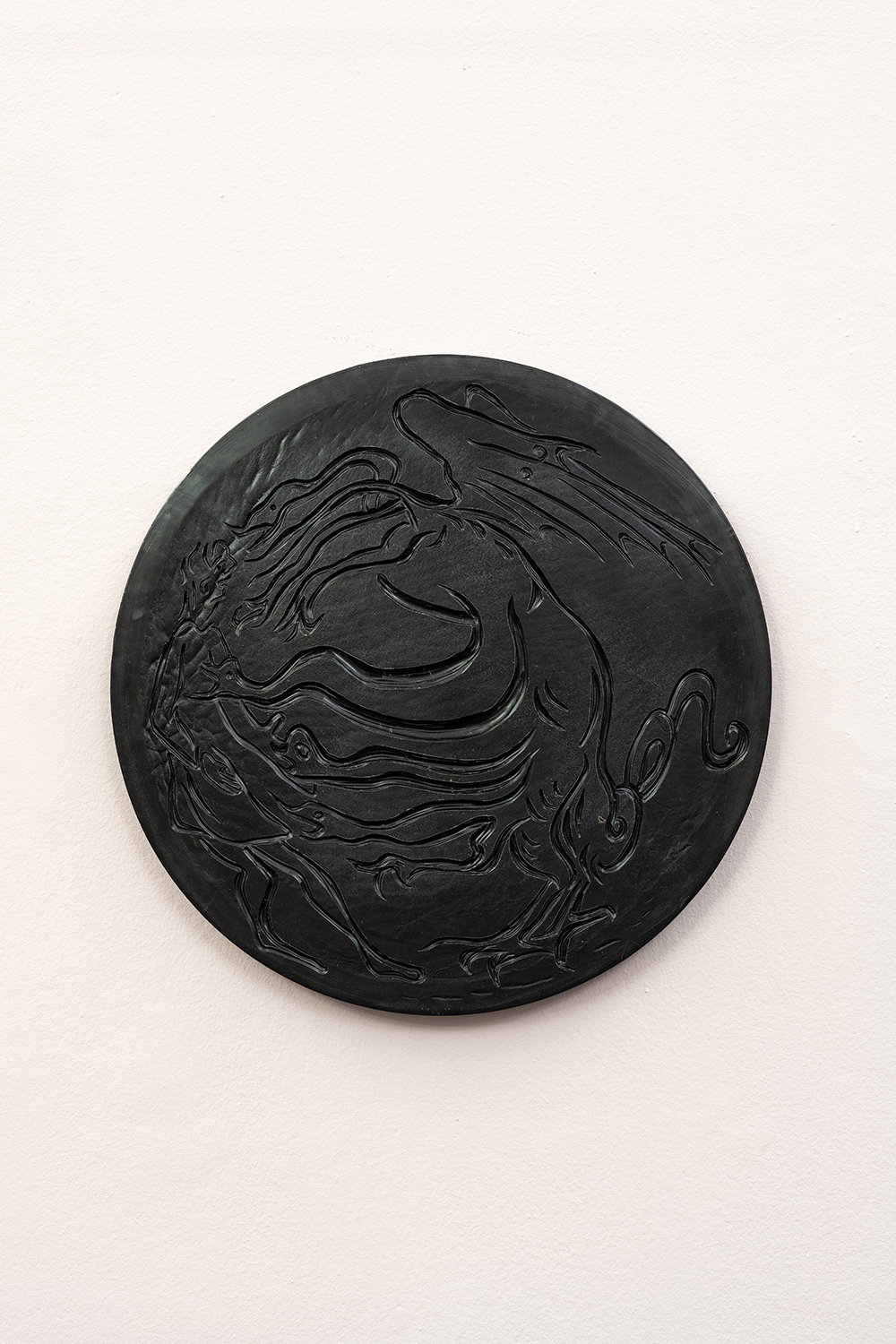
Mariana Castillo Deball, Around the polestar of your eyes which are empty, 2022, wax circle with black pigment and carved drawing Ø 50 cm, Installation view in the exhibition In a Convex Mirror, 2022, Pink Summer Contemporary Art, Genoa, Italy
Photo: Alice Moschin
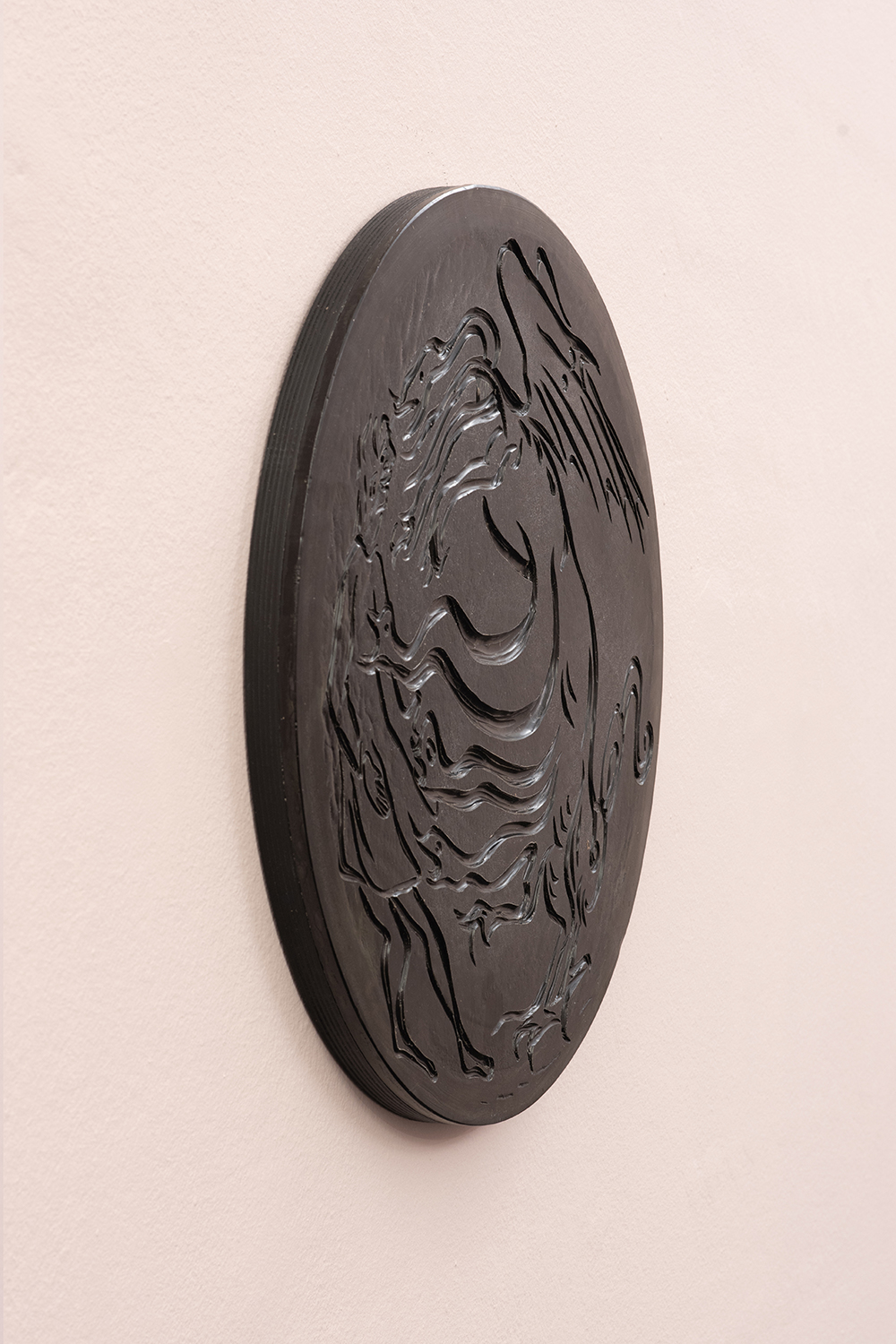
Mariana Castillo Deball, Around the polestar of your eyes which are empty, 2022, wax circle with black pigment and carved drawing Ø 50 cm, Installation view in the exhibition In a Convex Mirror, 2022, Pink Summer Contemporary Art, Genoa, Italy
Photo: Alice Moschin

Mariana Castillo Deball, Your round mirror which organizes everything, 2022, wax circle with black pigment and carved drawing Ø 50 cm, Installation view in the exhibition In a Convex Mirror, 2022, Pink Summer Contemporary Art, Genoa, Italy
Photo: Alice Moschin
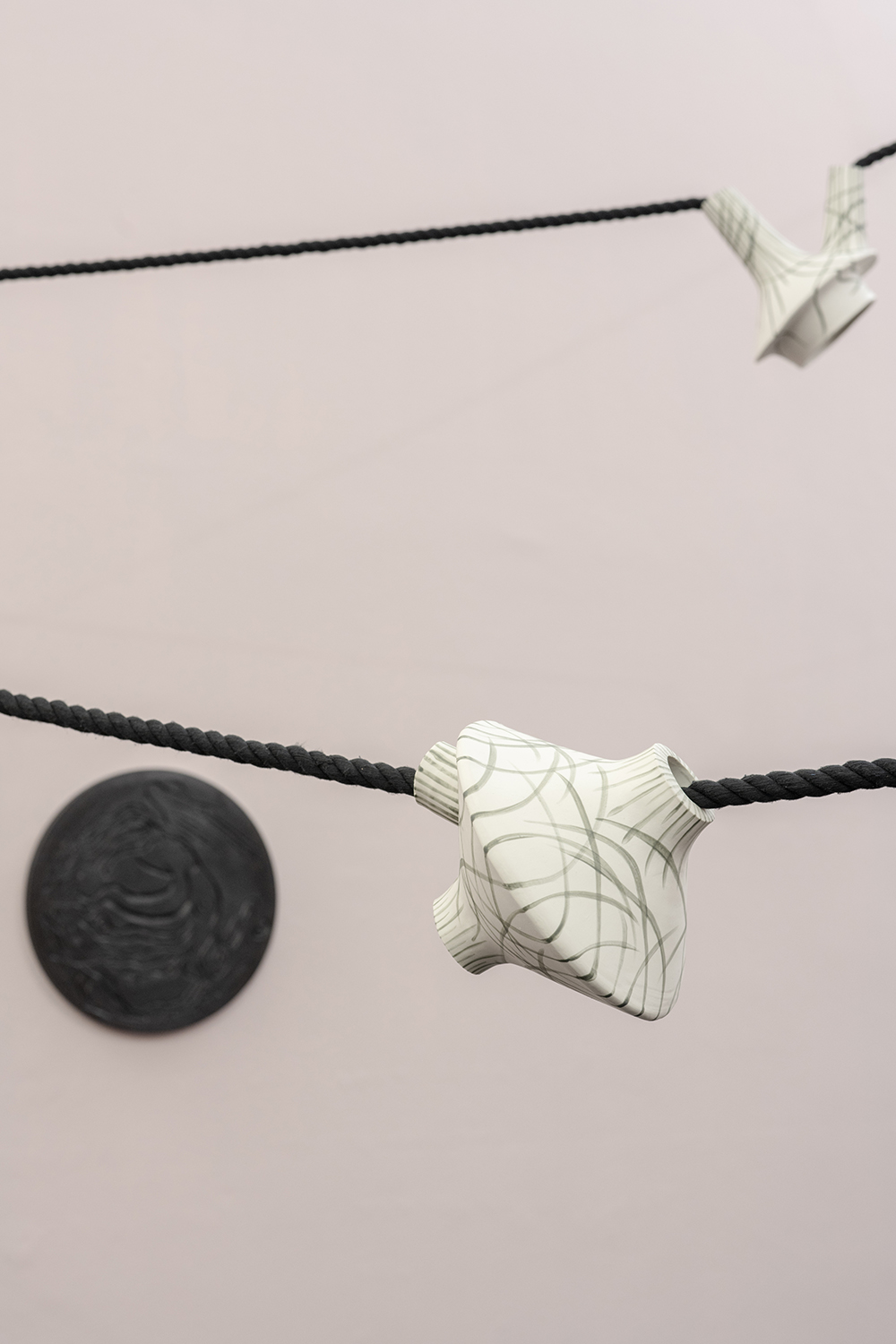
Mariana Castillo Deball, Exhibition of In a Convex Mirror, 2022, Pink Summer Contemporary Art, Genoa, Italy
Photo: Alice Moschin
By the position of your heart IT WILL BE KNOWN WHERE THE MIDDLE PLACE IS
Vleeshal, Middelburg, The Netherlands
December 8, 2021 – Februari 27, 2022
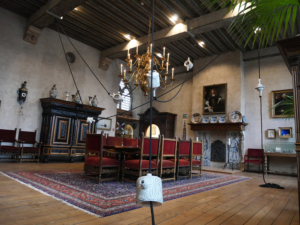
By the position of your heart IT WILL BE KNOWN WHERE THE MIDDLE PLACE IS, 2021, 8 ceramic vessels made of porcelain with engobe slip and connected with 100 meters of black cotton rope
Photos: Mariana Castillo Deball
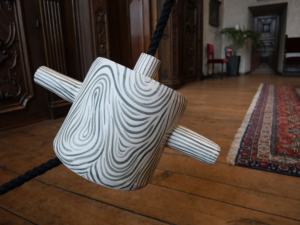
By the position of your heart IT WILL BE KNOWN WHERE THE MIDDLE PLACE IS, 2021, 8 ceramic vessels made of porcelain with engobe slip and connected with 100 meters of black cotton rope
Photos: Mariana Castillo Deball
The ceramic pieces in the suspended installation By the position of your heart IT WILL BE KNOWN WHERE THE MIDDLE PLACE IS resemble what archeologists call ‘kill holes’, or ancient pottery vessels that have perforations at their base. This deliberate removal of a receptacle’s function as a container is found to be a common practice, used for traditional burial rites in the American Southwestern region. Deball further manipulates these forms to create five imagined pieces connected by a rope, while also incorporating her 1998 sculptural investigation of the Klein bottle, a mathematical object that has no inside or outside. This formalistic exploration of ceramics is paired with Deball’s extensive research and mediation in science, archaeology, and the visual arts, specifically on how these disciplines describe the world.
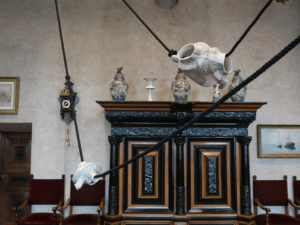
By the position of your heart IT WILL BE KNOWN WHERE THE MIDDLE PLACE IS, 2021, 8 ceramic vessels made of porcelain with engobe slip and connected with 100 meters of black cotton rope
Photos: Mariana Castillo Deball

By the position of your heart IT WILL BE KNOWN WHERE THE MIDDLE PLACE IS, 2021, 8 ceramic vessels made of porcelain with engobe slip and connected with 100 meters of black cotton rope
Photos: Mariana Castillo Deball
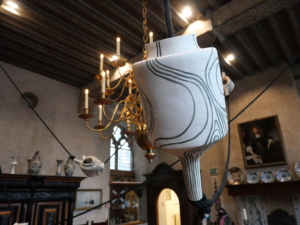
By the position of your heart IT WILL BE KNOWN WHERE THE MIDDLE PLACE IS, 2021, 8 ceramic vessels made of porcelain with engobe slip and connected with 100 meters of black cotton rope
Photos: Mariana Castillo Deball
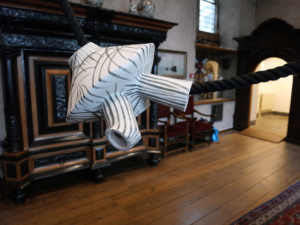
By the position of your heart IT WILL BE KNOWN WHERE THE MIDDLE PLACE IS, 2021, 8 ceramic vessels made of porcelain with engobe slip and connected with 100 meters of black cotton rope
Photos: Mariana Castillo Deball
BETWEEN MAKING AND KNOWING SOMETHING
Modern Art Oxford, Oxford, UK
October 2, 2020 – January 3, 2021
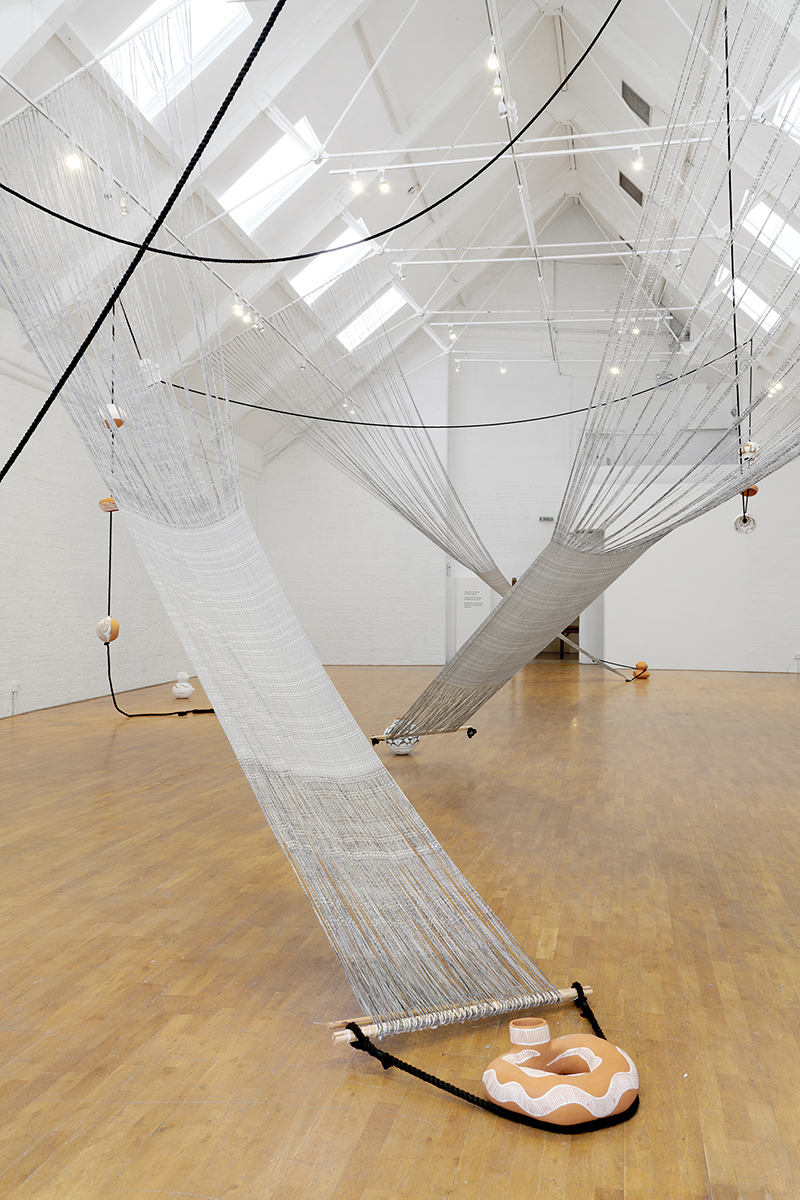
Installation view Between making and knowing something, Modern Art Oxford, Oxford UK, 2020. Photo: Helen Messenger
Between making and knowing something centers on how stories are performed and retained in museums, and makes visible lesser known practitioners and makers, whose histories have remained too long obscured. The exhibition explores the potential of objects to perform and retain stories by using modes of reproduction, ranging from pottery to weaving and photography, to give shape to and make visible the lives and objects of Zuni lhamana We’wha (1849–1896), her anthropological collaborator Matilda Coxe Stevenson (1849 –1915), Elsie Colsell McDougall (1879–1961) and Makereti (1873–1930). These four researchers and makers were active during the years anthropology was emerging as a discipline and, as the artist states, "there was no difference between making and knowing something".
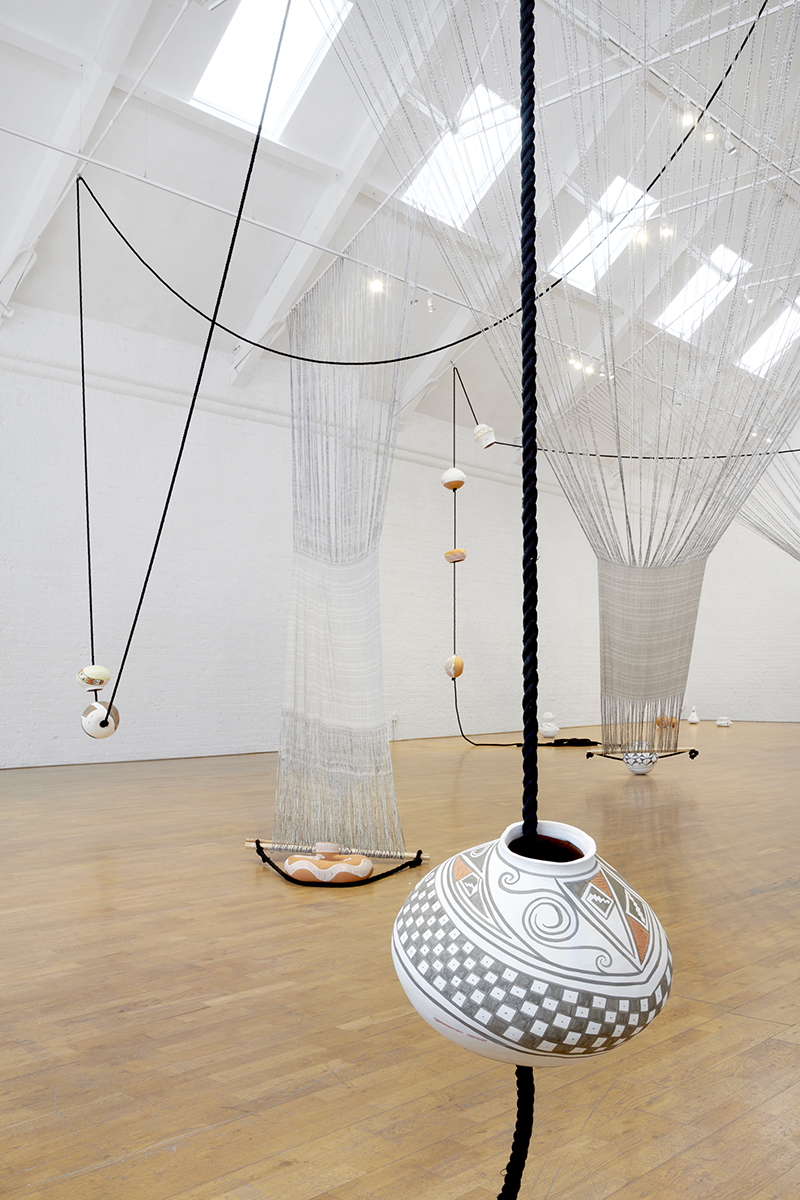
Detail: When the arms legs stretched, 2020.
19 ceramic vessels made of red stoneware painted with engobe slip, perforated and connected together with 100 meters of black cotton rope.
Produced with the assistance of ceramicist Silvia Andrade.
Photo: Helen Messenger
Between making and knowing something approaches these fascinating subjects in the manner of creative ‘case studies’ or ‘micro histories’, recalling the writing of Carlo Ginzburg who advocated for an alternative view of history by overlooking the dominant figures of power and concentrating on people who have no name, no voice, who have no documentation. As Deball says, "history is always viewed from the point of view of power, so how can you go down into the sources and find the history of people who have no voice?"
A dynamic installation of ceramics and textiles hangs from lengths of rope from the ceiling of Modern Art Oxford’s largest gallery. These ceramic vessels have been hand-made by the artist from red stoneware, referencing the painted designs and pottery techniques common to the Zuni, a Native American Pueblo people native to the Zuni River valley. Deball also studied artefacts originally made by We’wha who had a particular position in Zuni society as a berdache or ‘two-spirit’, or what Zunis refer to as an lhamana—the third gender or ‘man/ woman’; male-bodied people whoake on the social and ceremonial roles usually performed by women in their culture.

Detail: When the arms legs stretched, 2020
19 ceramic vessels made of red stoneware painted with engobe slip, perforated and connected together with 100 meters of black cotton rope.
Produced with the assistance of ceramicist Silvia Andrade.
Photo: Helen Messenger

Detail: When the arms legs stretched, 2020
19 ceramic vessels made of red stoneware painted with engobe slip, perforated and connected together with 100 meters of black cotton rope.
Produced with the assistance of ceramicist Silvia Andrade.
Photo: Helen Messenger
Stevenson was one of the first women to embark on a career in anthropology. On an expedition to the Southwest of America in 1889 she forged a close relationship with We’wha during fieldwork into Zuni culture. Stevenson is a controversial figure among the Zuni people because the documentation of their rituals is forbidden, and as such her photographs are rarely published today. We’wha was invited to the Smithsonian to produce many objects on site, with Stevenson extensively photographing her processes of fabrication. The material contributions We’wha made during this time, including pottery, looms, prayer feathers, woven belts, and textiles, were reportedly accessioned into the Smithsonian collections and have recently been attributed to We’wha.
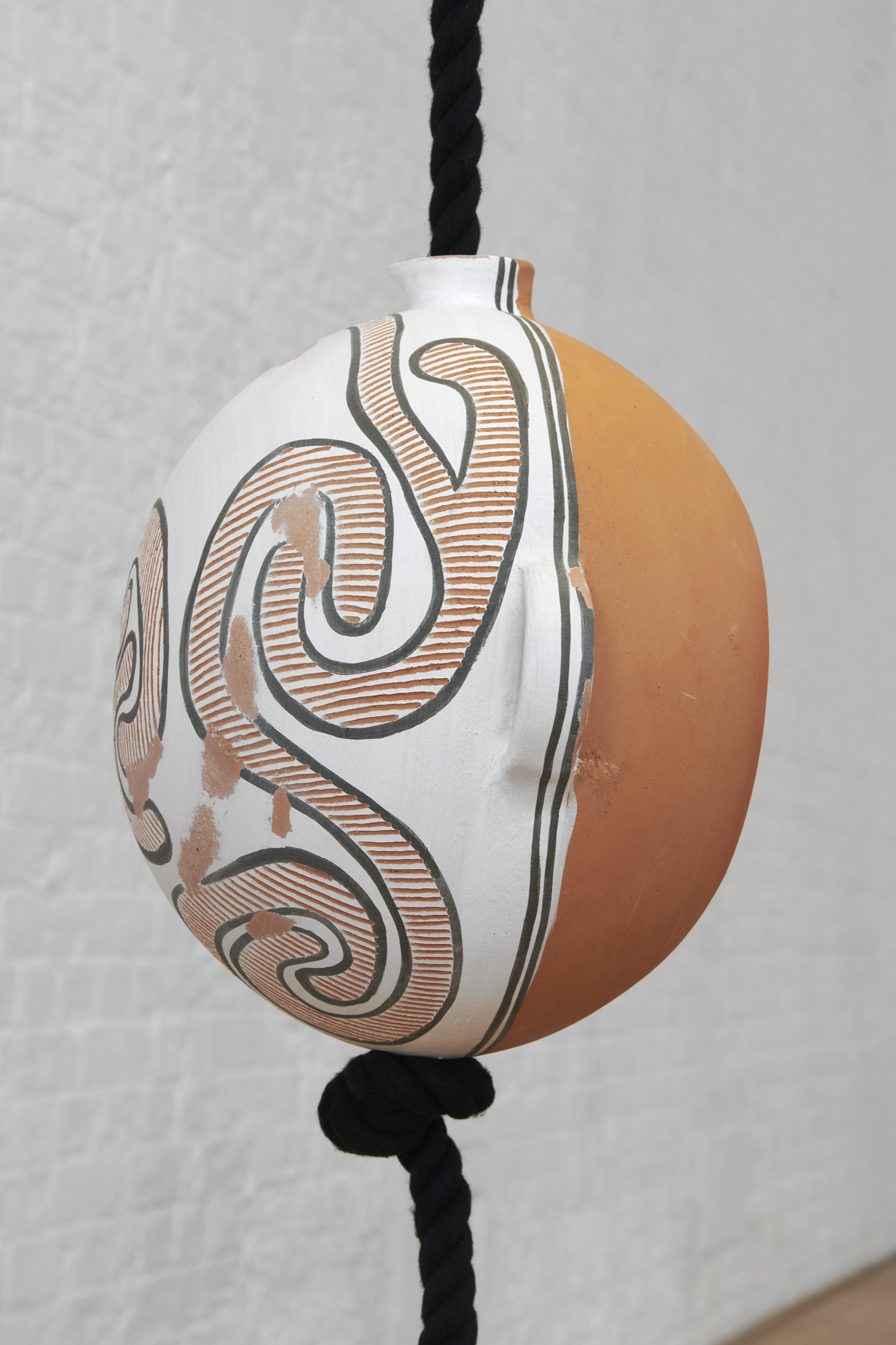
Detail: When the arms legs stretched, 2020.
Photo: Helen Messenger
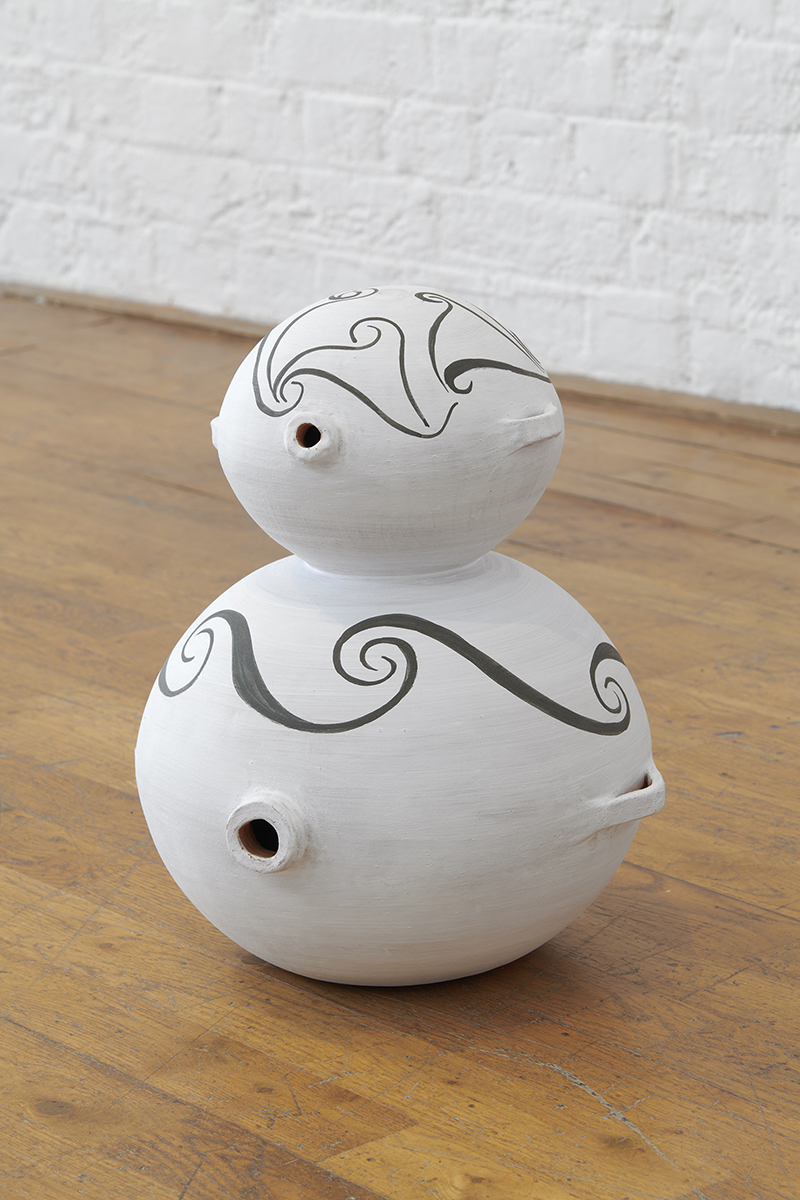
Detail: When the arms legs stretched, 2020.
Photo: Helen Messenger
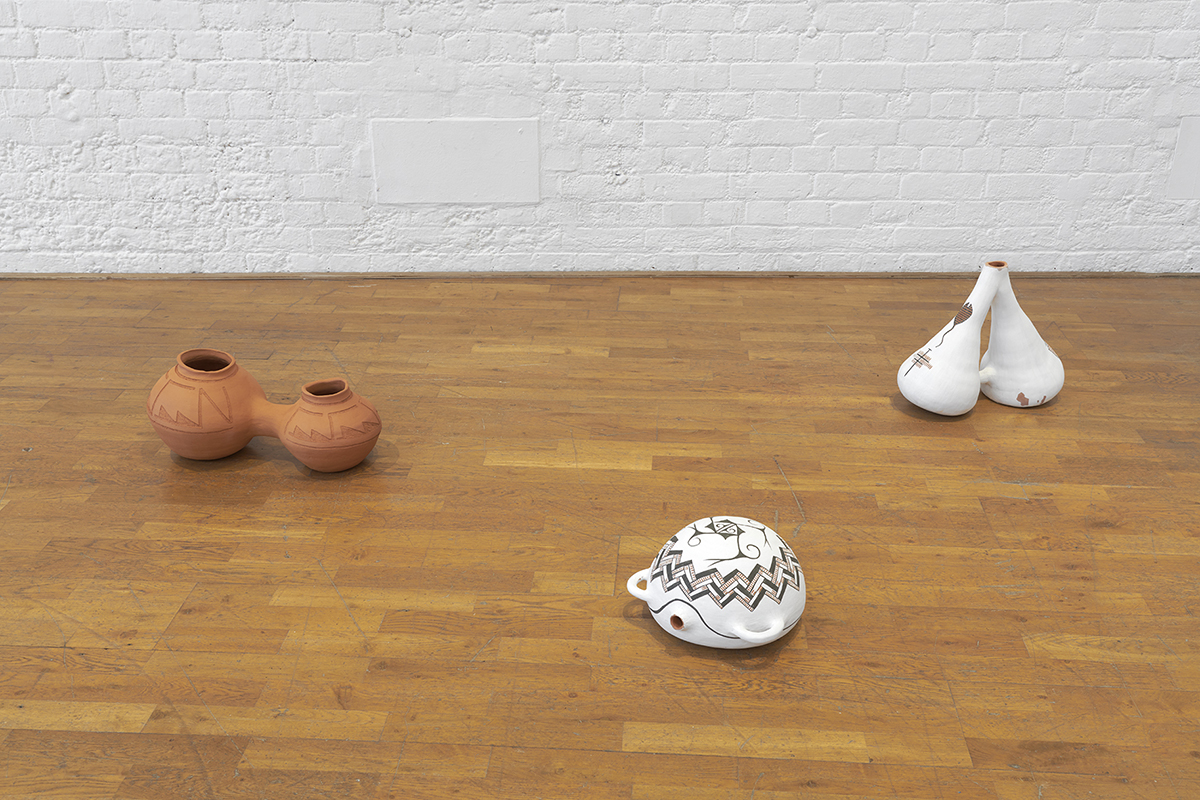
Detail: When the arms legs stretched, 2020.
19 ceramic vessels made of red stoneware painted with engobe slip, perforated and connected together with 100 meters of black cotton rope.
Produced with the assistance of ceramicist Silvia Andrade. Photo: Helen Messenger

Detail: When the arms legs stretched, 2020.
19 ceramic vessels made of red stoneware painted with engobe slip, perforated and connected together with 100 meters of black cotton rope.
Produced with the assistance of ceramicist Silvia Andrade.
Photo: Helen Messenger.
Photo: Helen Messenger
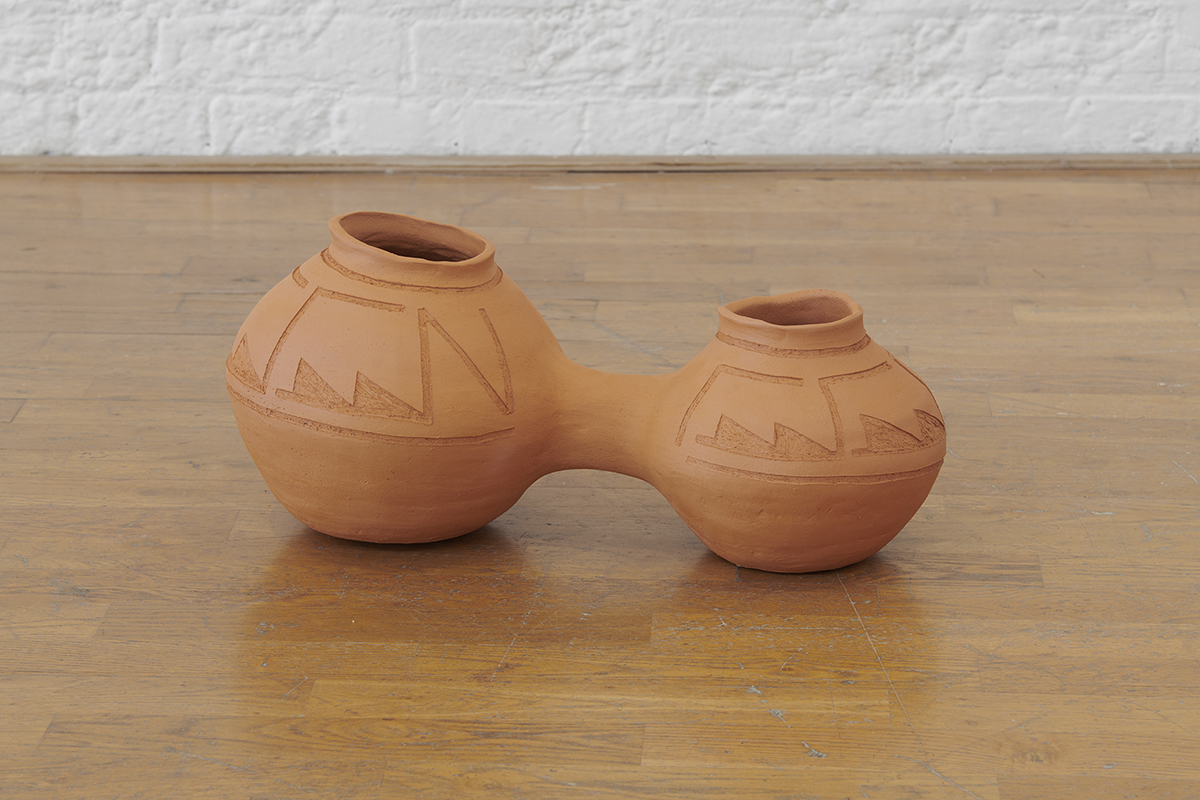
Detail: When the arms legs stretched, 2020. Photo: Helen Messenger
19 ceramic vessels made of red stoneware painted with engobe slip, perforated and connected together with 100 meters of black cotton rope.
Produced with the assistance of ceramicist Silvia Andrade
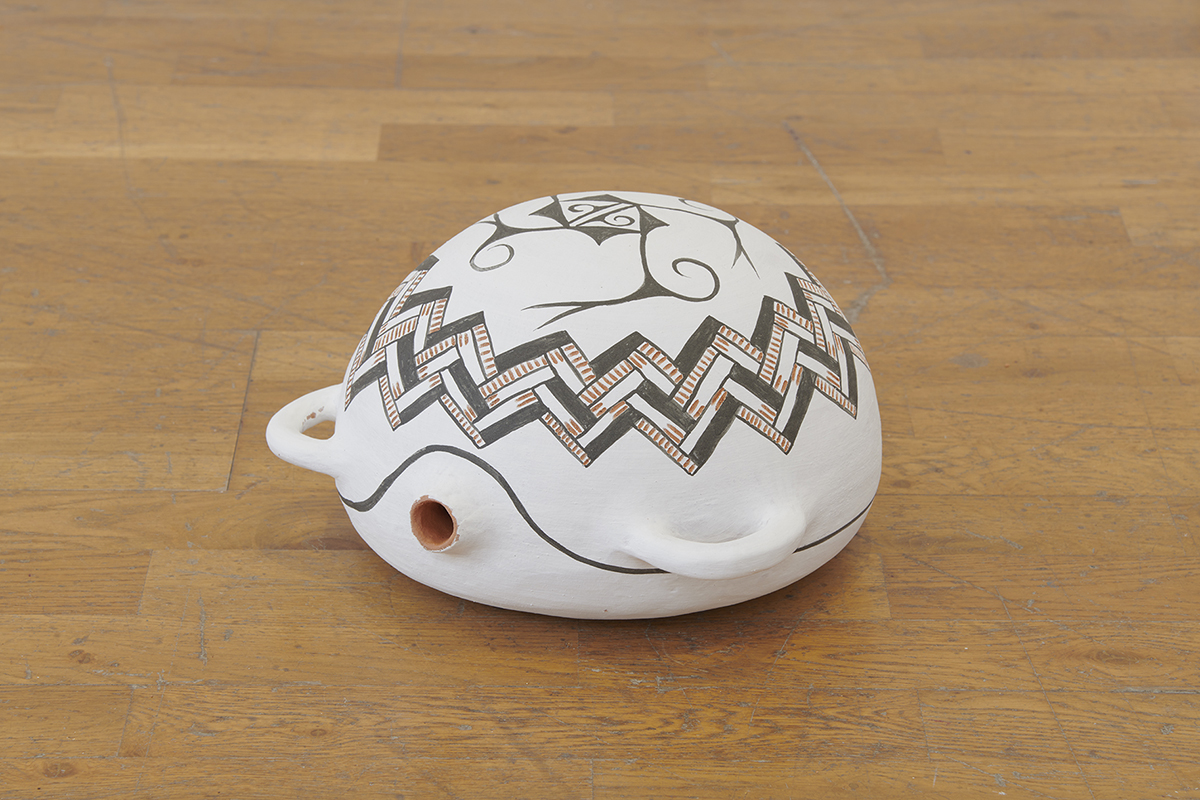
Detail: When the arms legs stretched, 2020
19 ceramic vessels made of red stoneware painted with engobe slip, perforated and connected together with 100 meters of black cotton rope.
Produced with the assistance of ceramicist Silvia Andrade.
Photo: Helen Messenger
Through the three woven textiles tethered to the floor and ceiling Deball reconnects the objects of intrepid traveller Elsie Colsell McDougall’s anthropological study to their communities of origin. McDougall spent her life researching the indigenous textile cultures of Central America, first visiting distant and isolated Maya villages in Guatemala and Mexico in 1926 to observe and document weaving materials and techniques. Each swathe of hanging handmade fabric is an unfinished rebozo, long flat garments similar to shawls, often worn by women in Mexico and considered part of Mexican identity. Ukata, a collective of weavers based in the state of Michoacán in Mexico, were commissioned to create these fabrics woven with a backstrap loom, and dyed with an ikat pattern. Deball offers a renewed perspective on McDougall’s research by employing the labour of local makers who continue to use the weaving techniques and skills McDougall extensively documented. Their seemingly unfinished threads suggest the continued use and relevance of these traditional garments in Mexico today.

Detail: All around to the oceans, 2020
Three hand-woven rebozos dyed with an ikat pattern and displayed with backstrap looms.
Produced in the state of Michoacán, Mexico by Ukata. Photo: Helen Messenger
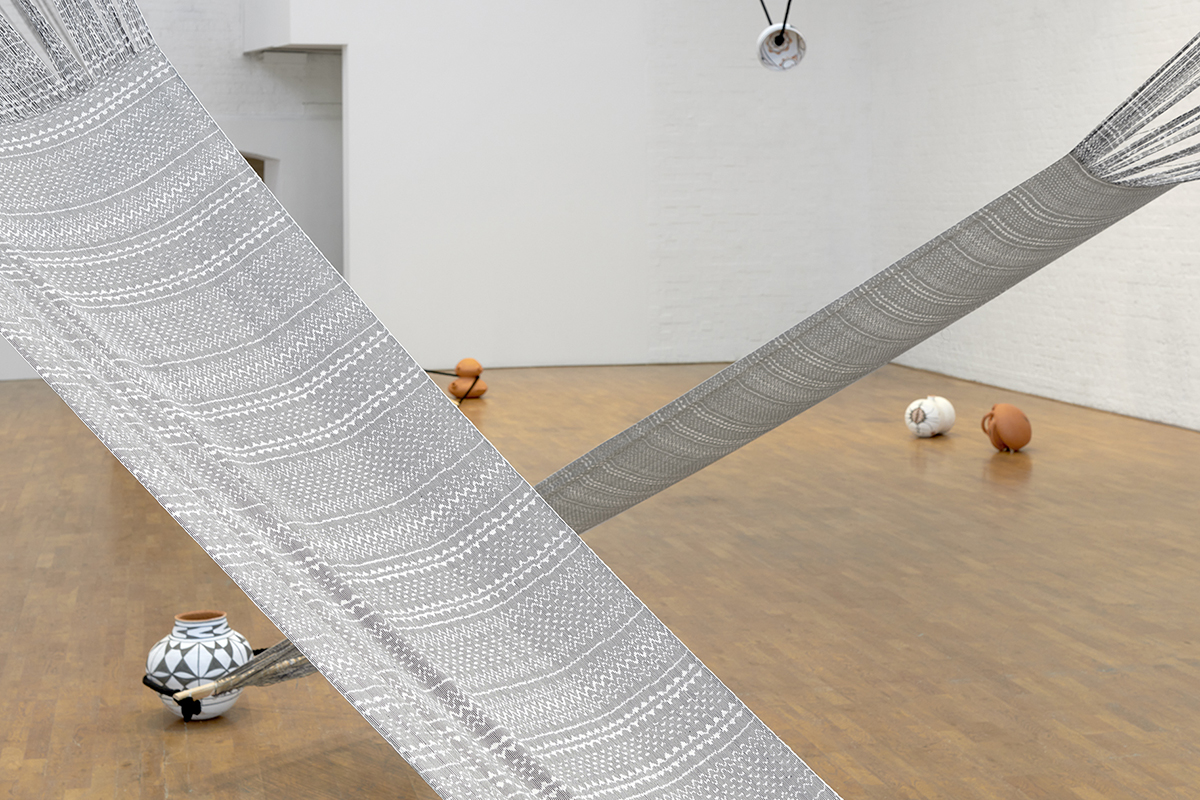
Detail: All around to the oceans, 2020
Three hand-woven rebozos dyed with an ikat pattern and displayed with backstrap looms.
Produced in the state of Michoacán, Mexico by Ukata. Photo: Helen Messenger
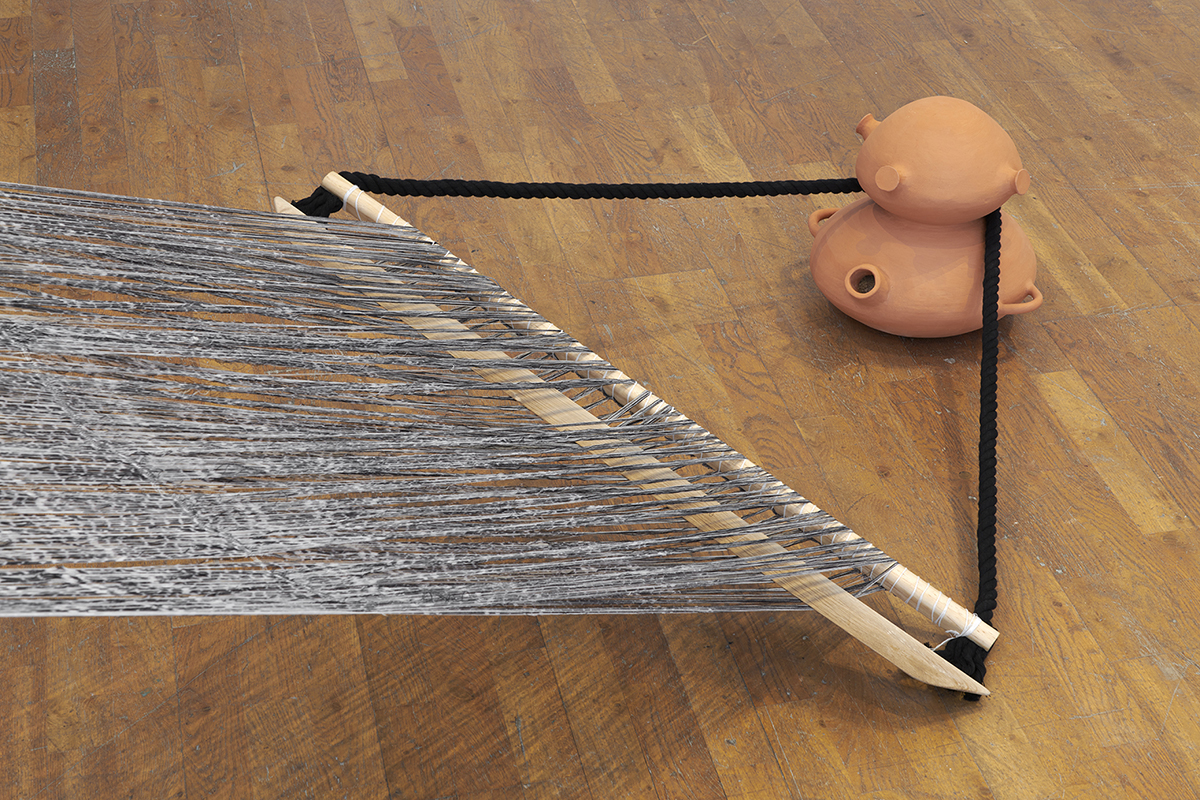
Detail: All around to the oceans, 2020
Three hand-woven rebozos dyed with an ikat pattern and displayed with backstrap looms.
Produced in the state of Michoacán, Mexico by Ukata. Photo: Helen Messenger
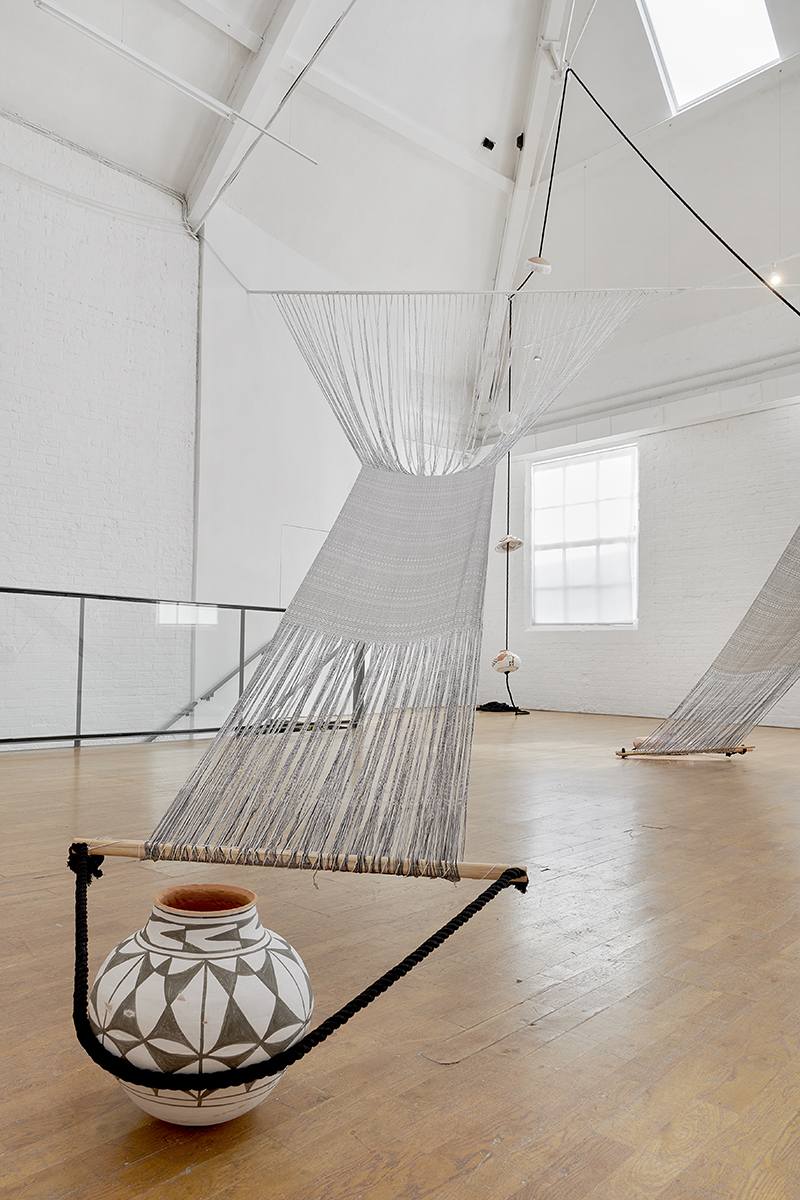
Detail: A_____LL Around I, 2020
ceramic vessel made of red stoneware painted with engobe slip. Hand-woven textile dyed with an ikat pattern and displayed with backstrap looms produced in the state of Michoacán, Mexico by Ukata.
Produced with the assistance of ceramicist Silvia Andrade
Photographs courtesy of the Pitt Rivers Museum, Oxford.
Photo: Helen Messenger
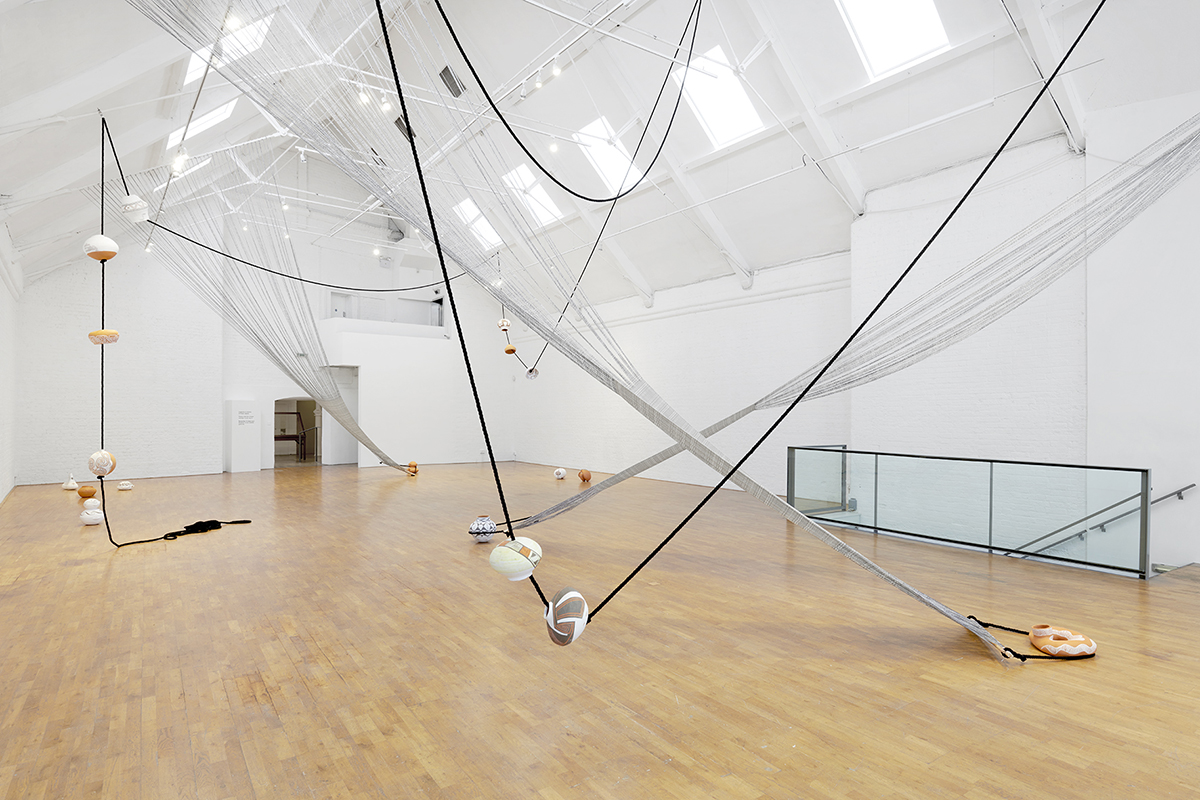
Installation view Between making and knowing something, Modern Art Oxford, Oxford UK, 2020

Elsie McDougall fieldwork photography, parts of wooden backstrap looms
Photographs courtesy of the Pitt Rivers Museum, Oxford.
Museum cases courtesy of the Oxford University Museum of Natural History. Photo: Helen Messenger

Elsie McDougall fieldwork photography, parts of wooden backstrap looms
Photographs courtesy of the Pitt Rivers Museum, Oxford
Museum cases courtesy of the Oxford University Museum of Natural History. Photo: Helen Messenger
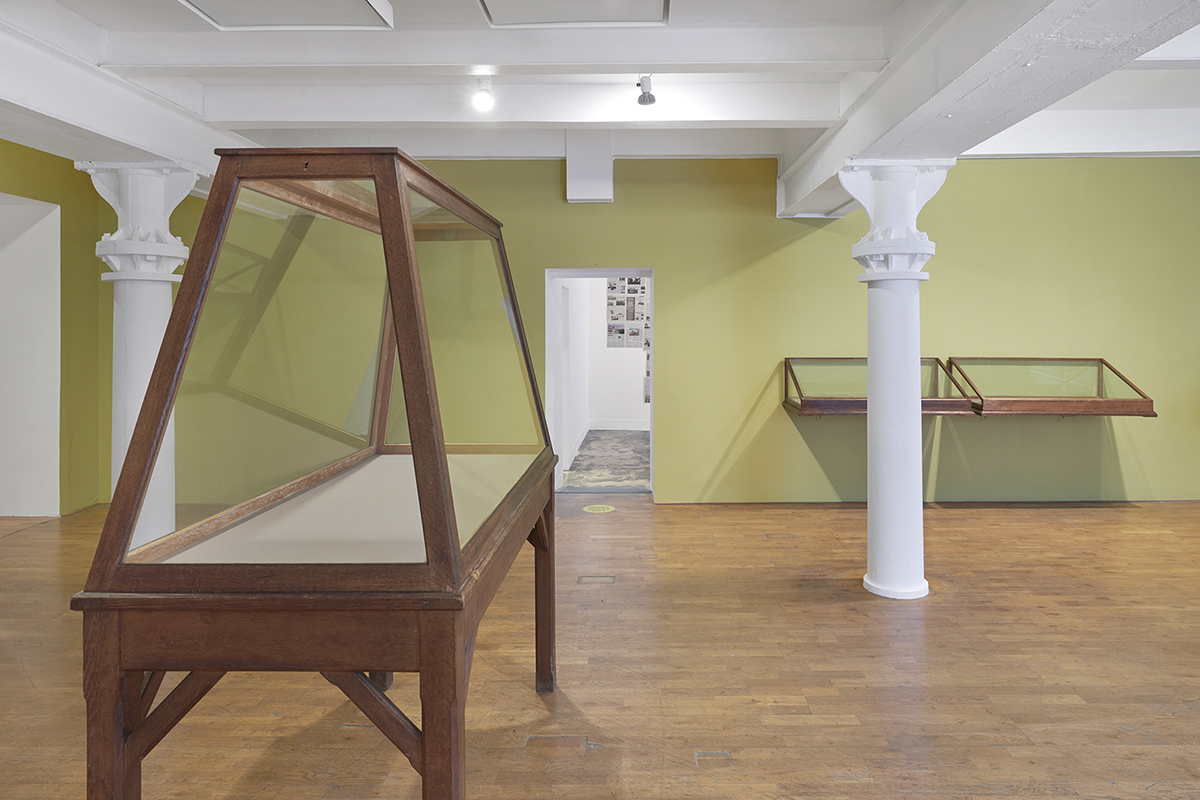
Makereti fieldwork photography, book and postcards, 2020
Photographs courtesy of the Pitt Rivers Museum, Oxford, and the Alexander Turnball Library Collection, New Zealand.
Museum cases courtesy of the Oxford University Museum of Natural History. Photo: Helen Messenger
A series of 19th century museum vitrines loaned from the Oxford University Museum of Natural History have been repurposed by Deball to display McDougall’s photographs, alongside the photographic archives of Makereti (1873–1930). Makereti, the daughter of an English general and chief of the Maori Arawa tribe, was a famous tour guide in New Zealand who became known for escorting visitors through the geyser valley of Whakarewarewa near Rotorua. She established a career as a highly regarded ambassador and interpreter for Maori culture in the late Victorian period. In 1924 Makereti enrolled as an anthropology student at the University of Oxford and went on to make significant contributions of Maori objects to the Pitt Rivers Museum, donating her personal collection of wood carvings, weapons, ornaments, feathers and flaxen coats and other Maori possessions she brought with her from New Zealand, which are still displayed at the museum today.
Deball’s final artwork in the exhibition speculates on an alternative view of history by providing an audio guide for a museum artefact which has been removed from view. Deball describes the history of an archaeological object in the Pitt Rivers Museum collection which cannot be seen, indicated by a museum display case which lies empty. Displays index the relationships between people and things, these devices transform ‘things into objects’ and can be interpreted as catalysts for mechanism of institutional power. In an exhibition of reproductions and copies, Deball shifts the focus away from questions of authenticity and the veracity of an original artwork, to instead allow visitors space for imagination and their own interpretation.
Curated by Amy Budd
Resources: Between making and knowing something Exhibition Notes
Between making and knowing something Virtual Exhibition

Makereti fieldwork photography, book and postcards, 2020
Photographs courtesy of the Pitt Rivers Museum, Oxford, and the Alexander Turnball Library Collection, New Zealand.
Museum cases courtesy of the Oxford University Museum of Natural History. Photo: Helen Messenger
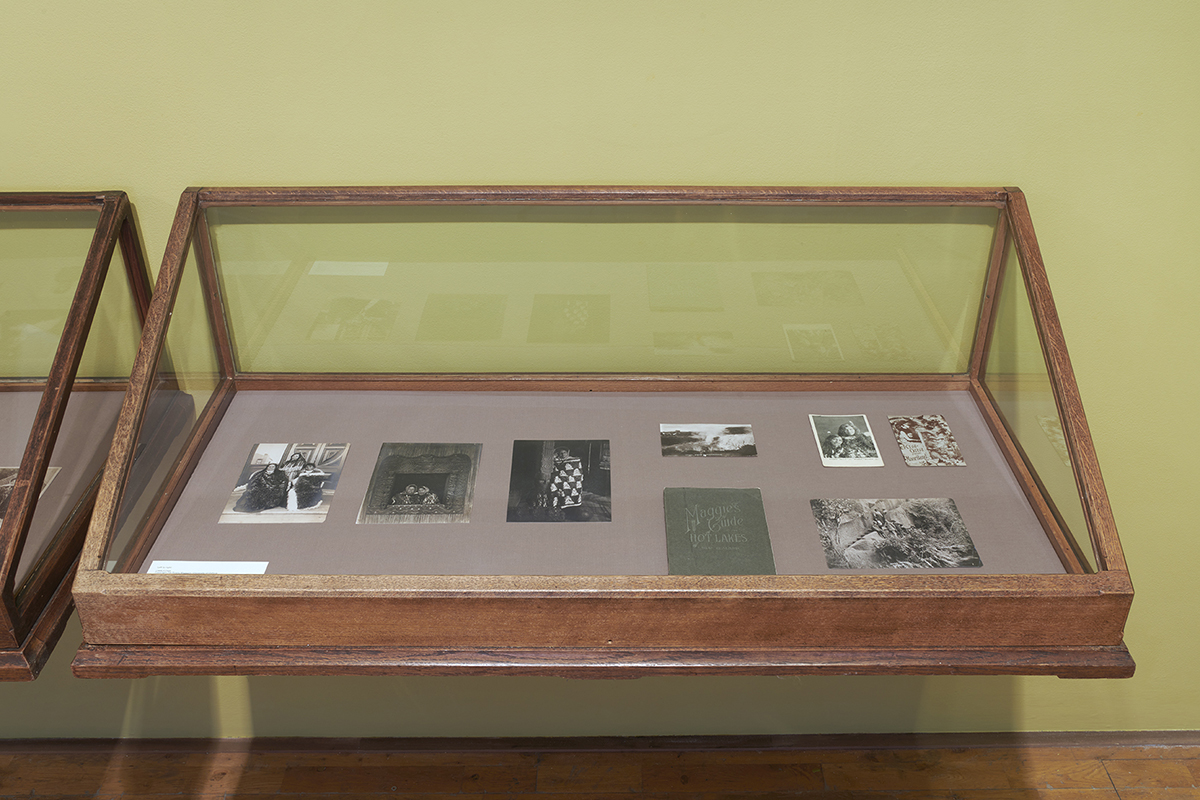
Makereti fieldwork photography, book and postcards, 2020. Photo: Helen Messenger
Photographs courtesy of the Pitt Rivers Museum, Oxford, and the Alexander Turnball Library Collection, New Zealand.
Museum cases courtesy of the Oxford University Museum of Natural History
FEATHERED CHANGES, SERPENT DISAPPEARANCES
San Francisco Art Institute, San Francisco
Apr 14 – Jul 30, 2016
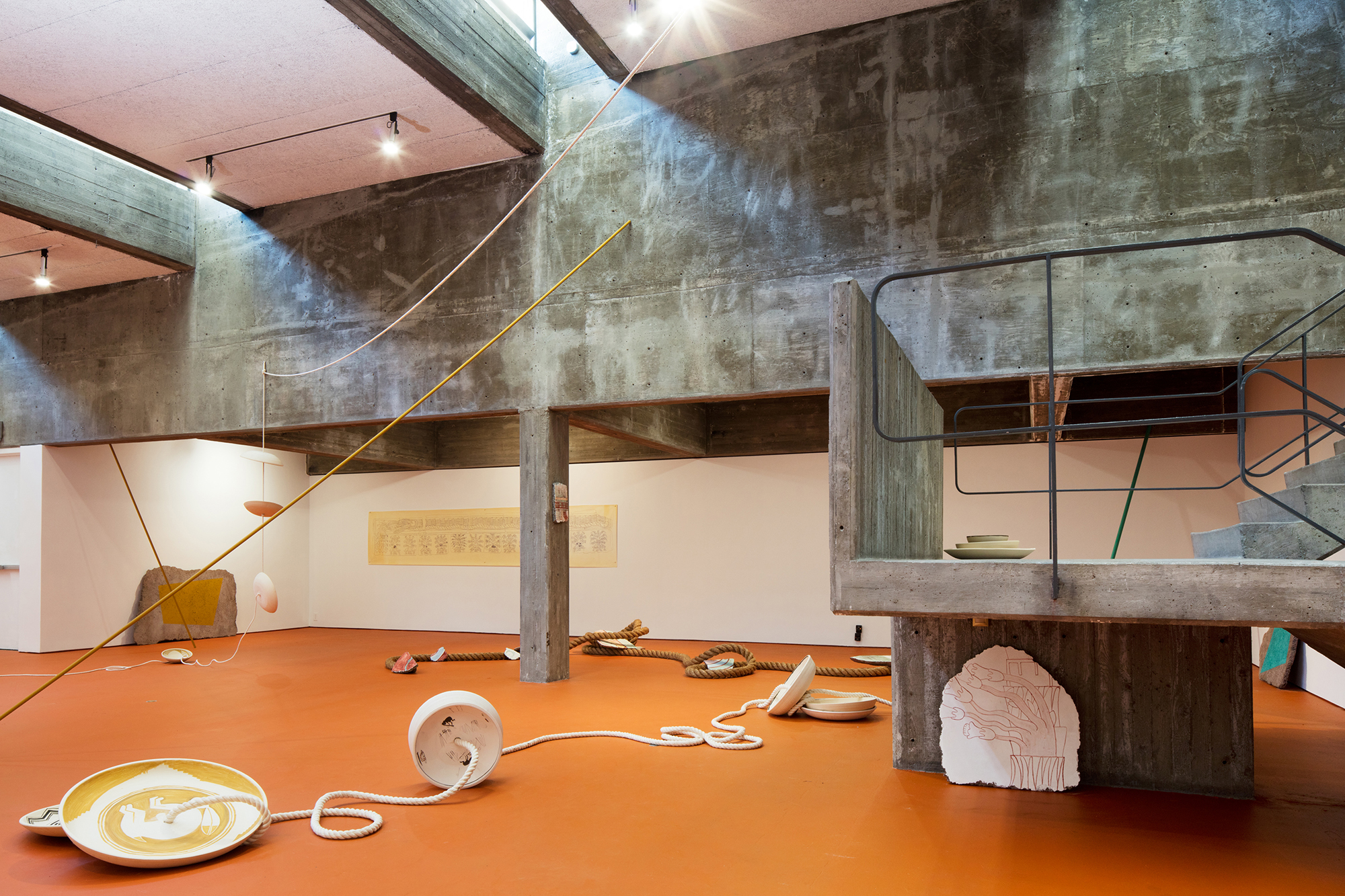
Installation view Feathered Changes, Serpent Disappearances, San Francisco Art Institute, San Francisco, USA, 2016.
Feathered Changes, Serpent Disappearances presents an archaeological search for absence and a study in the gaps of memory. What role does chance—in the form of lapsed time, erosion, fragmentation, and human intervention—play in our subjective interpretation of history?By lingering on the unknown histories of artifacts, Deball underscores the effects of natural and social processes within archaeological narratives.
The exhibition presents a new vision of archaeology – one that acknowledges ghosts, double visions, and multiple versions of history. The artifacts unearthed through different research originate in local archives but gesture toward sites much further afield: the ancient Mexican civilization at Teotihuacan, ceramic funereal traditions of the Southwestern Mimbres culture and their echoes in Mayan pottery, and the carved stone reliefs of pre-Columbian cultures throughout Central America. Through large-scale fragments, rubbings, ceramics, and fresco works, Feathered Changes, Serpent Disappearances overlays and blends these disparate narratives, splicing them together into a collage of archaeological time.
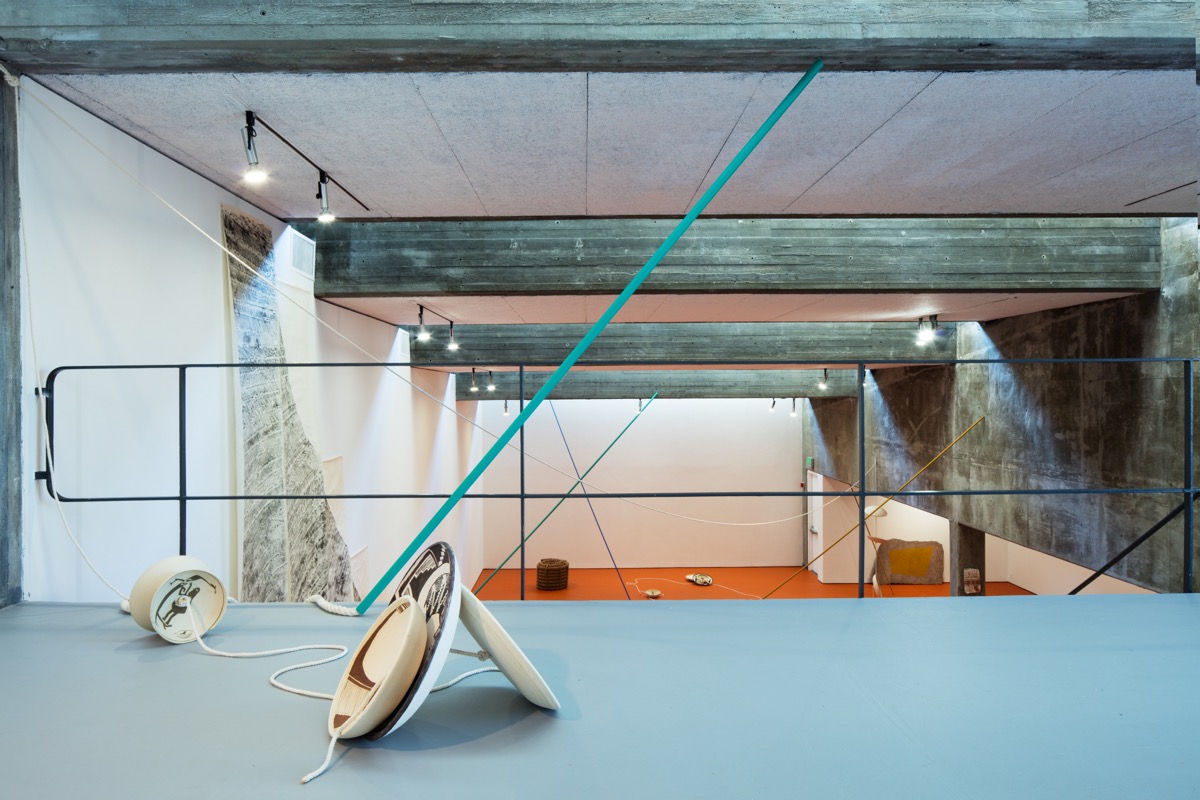
Tree Fish Figure Kill Hole Sequence, 2016
Low-fire stoneware with mason stain
Composer and visual artist John Cage theorized that the unknown can be a productive force in art-making, that indeterminacy creates space, and can open up new concepts of time. Using a randomized script based on his chance-based artistic scores, Deball has choreographed the placement and movement of her artworks and architectural framework throughout the duration of the exhibition.
The exhibition employs Cage's philosophy on chance as a tool of archaeological inquiry in order to evoke time and challenge the human urge to produce fixed meanings from our past.
Feathered Changes, Serpent Disappearances was co-presented by San Francisco Art Institute and Kadist Art Foundation. The exhibition was organized by SFAI Assistant Curator Katie Hood Morgan with SFAI + Kadist Fellow Christopher Squier.
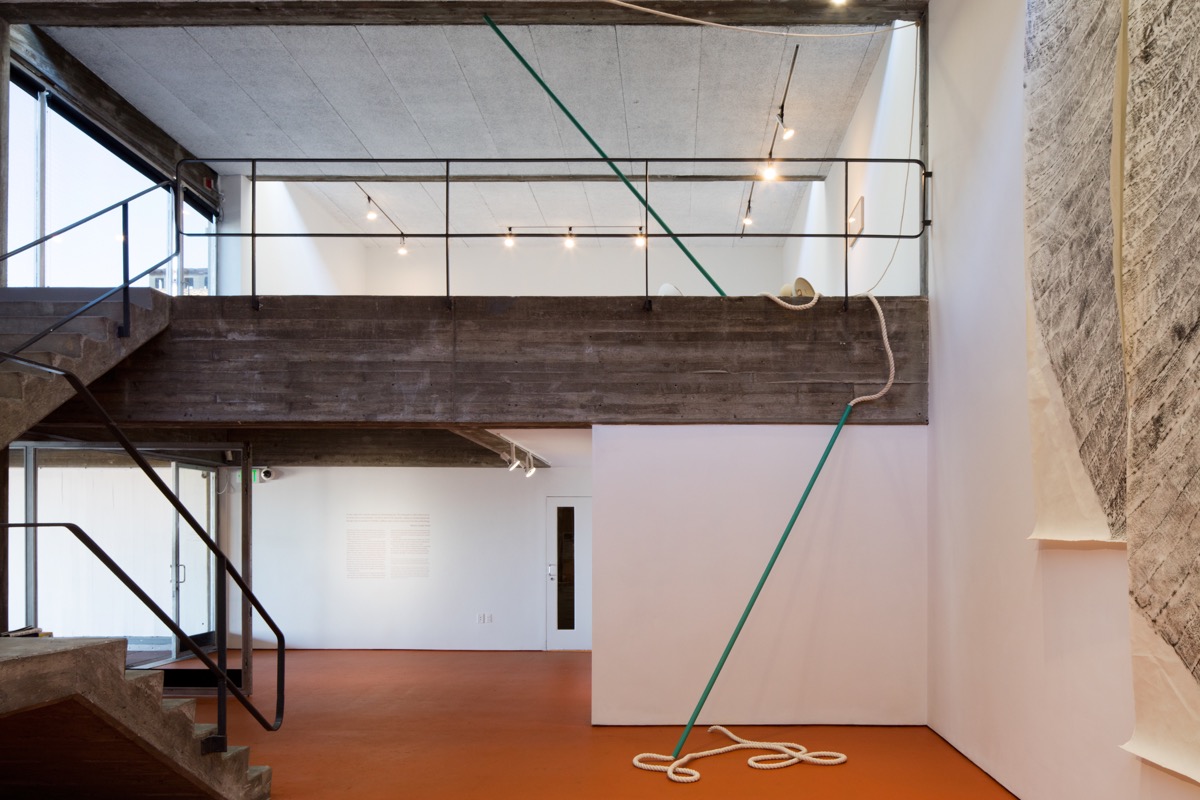
Turquoise North, 2016
2 spray-painted metal tubes and thick rope

Feathered Serpent and Flowering Trees
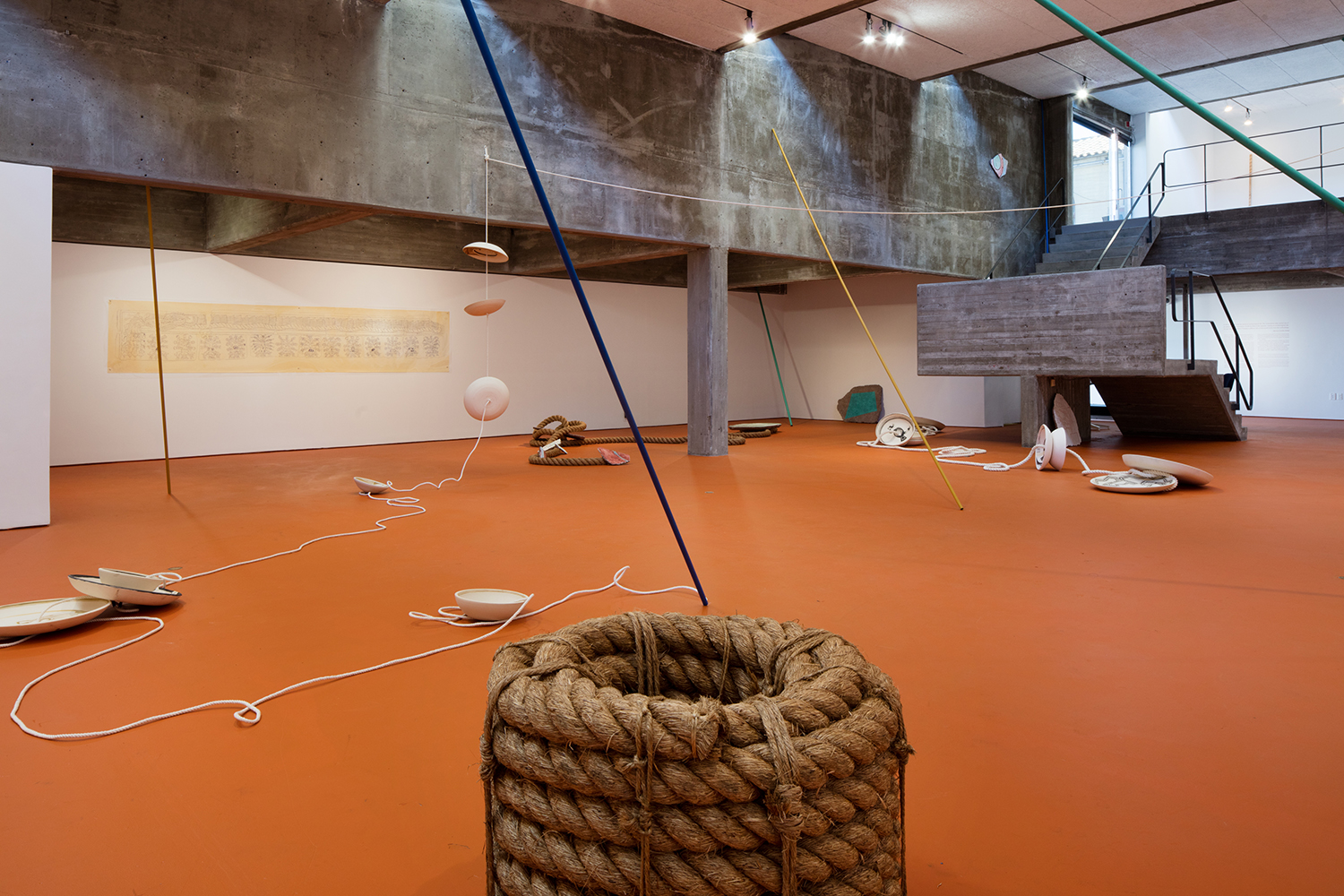
Installation view Feathered Changes, Serpent Disappearances, San Francisco Art Institute, San Francisco, USA, 2016.
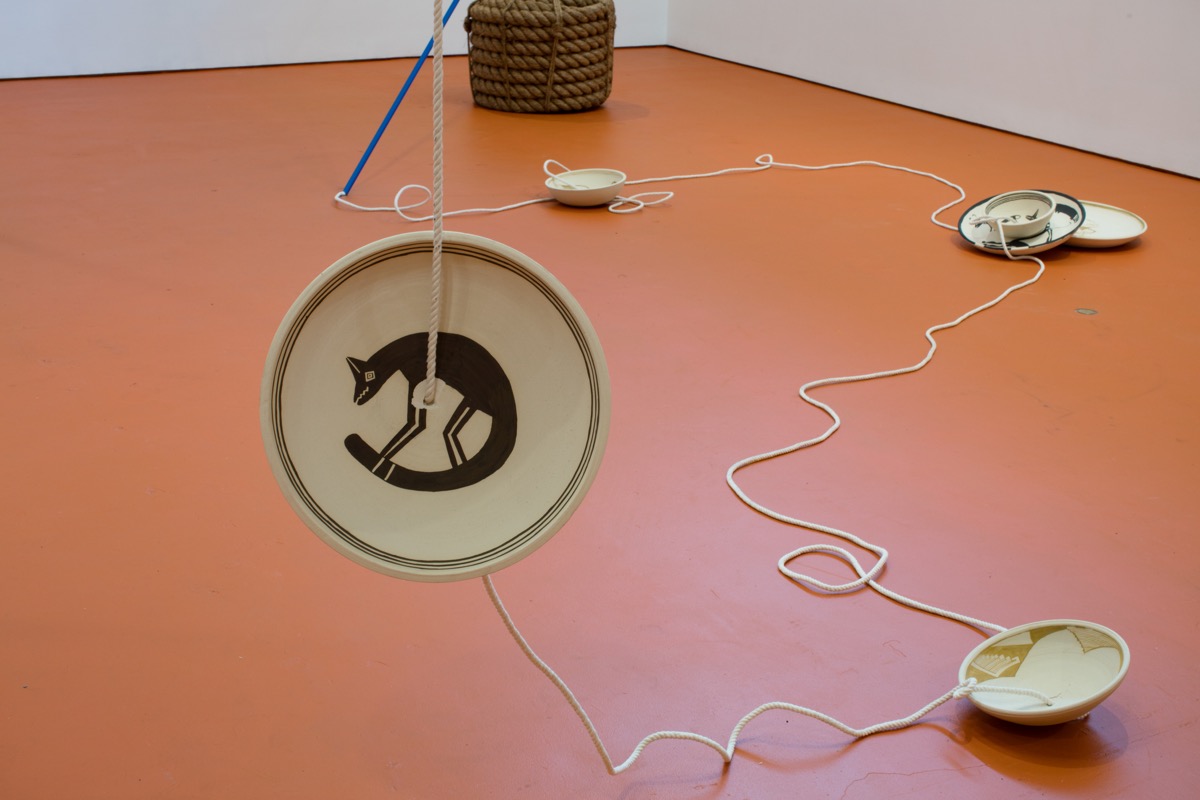
Detail: Coyote Bee Eye Kill Hole Sequence, 2016
Rope bale, blue tube, ceramic plates and long thin rope
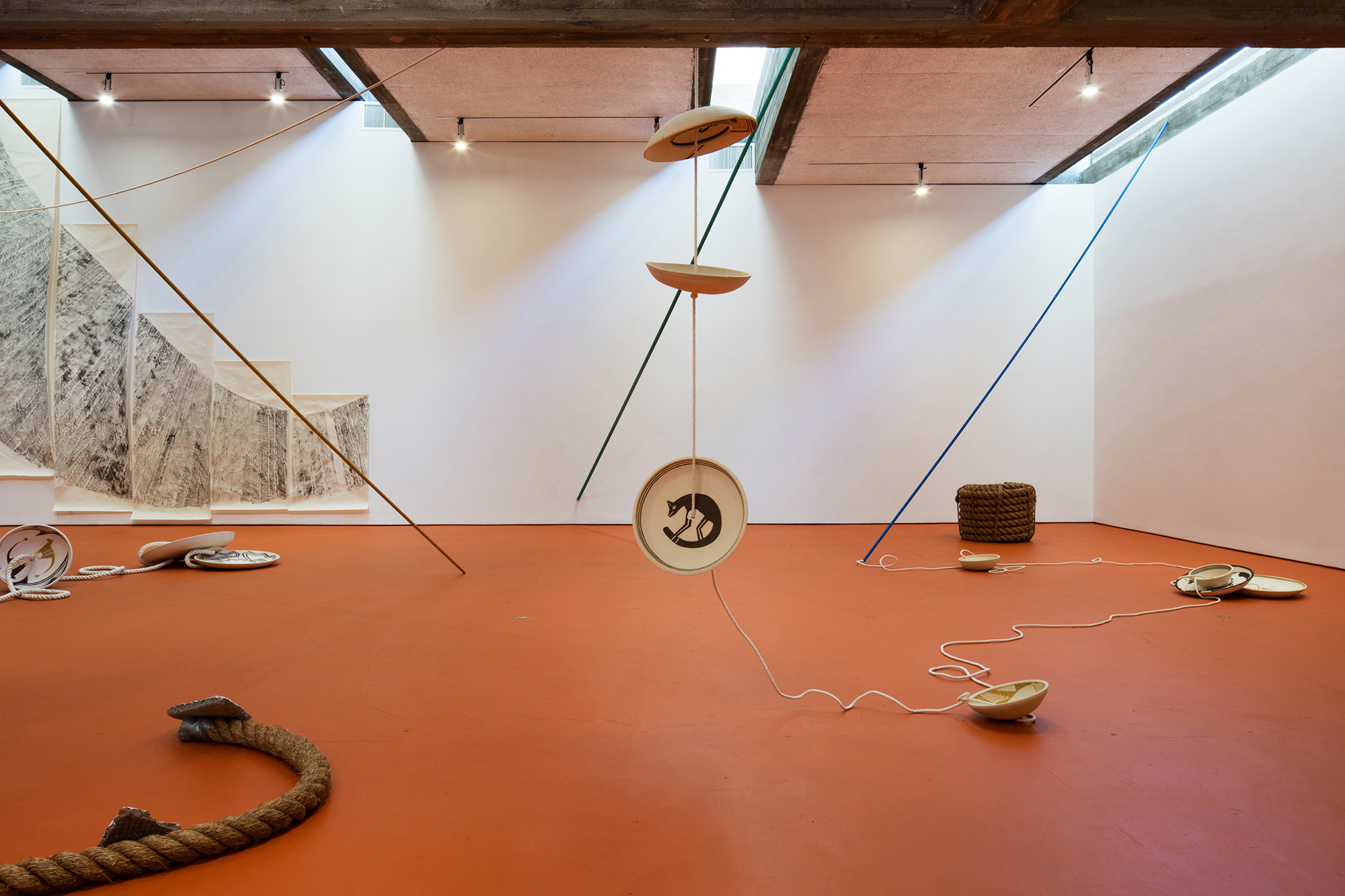
Installation view Feathered Changes, Serpent Disappearances, San Francisco Art Institute, San Francisco, USA, 2016.

Serpent disappearances, 2015
Rope and mural fragments; concrete with wire and plaster
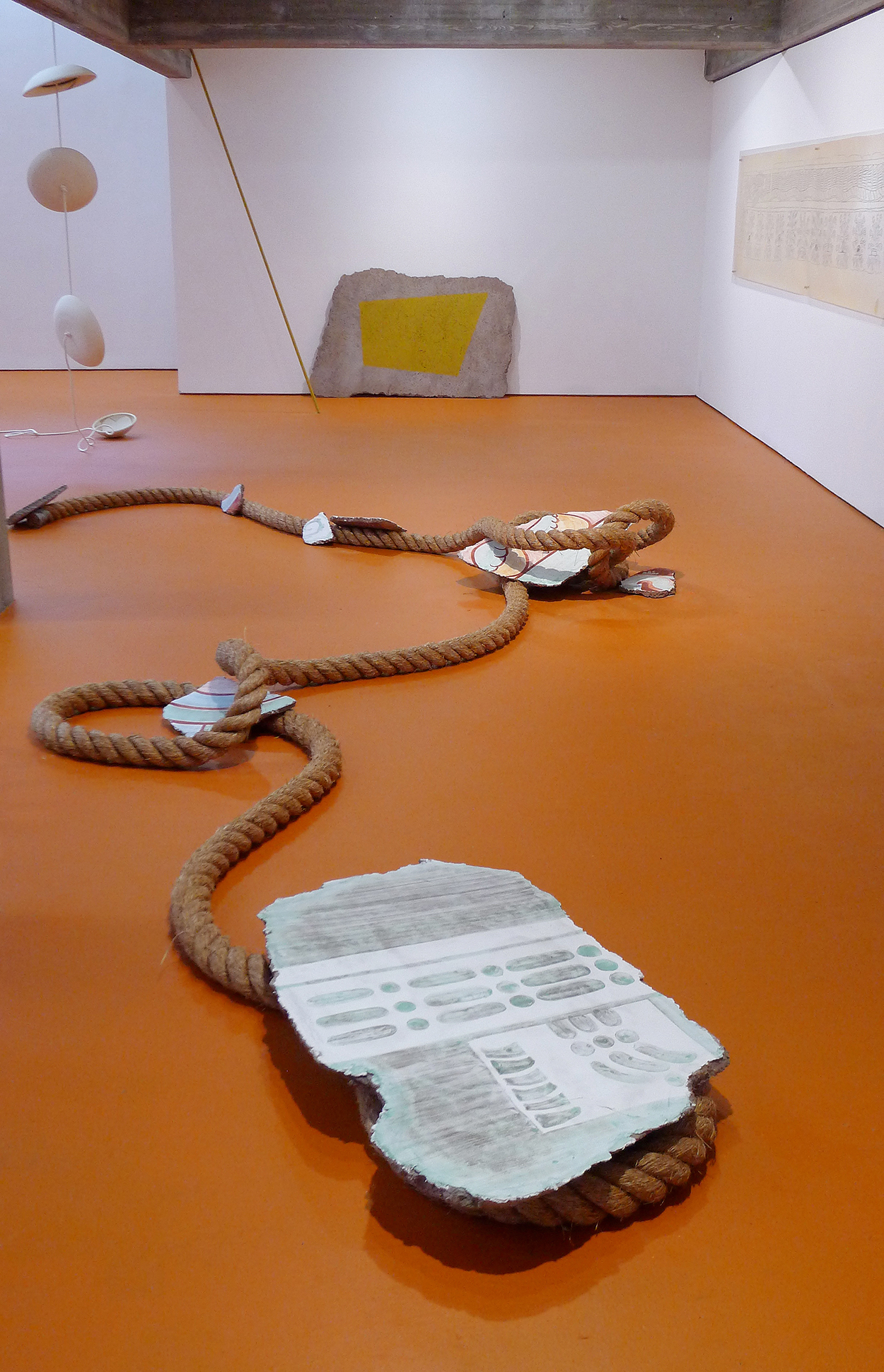
Serpent disappearances, 2015
Rope and mural fragments; concrete with wire and plaster
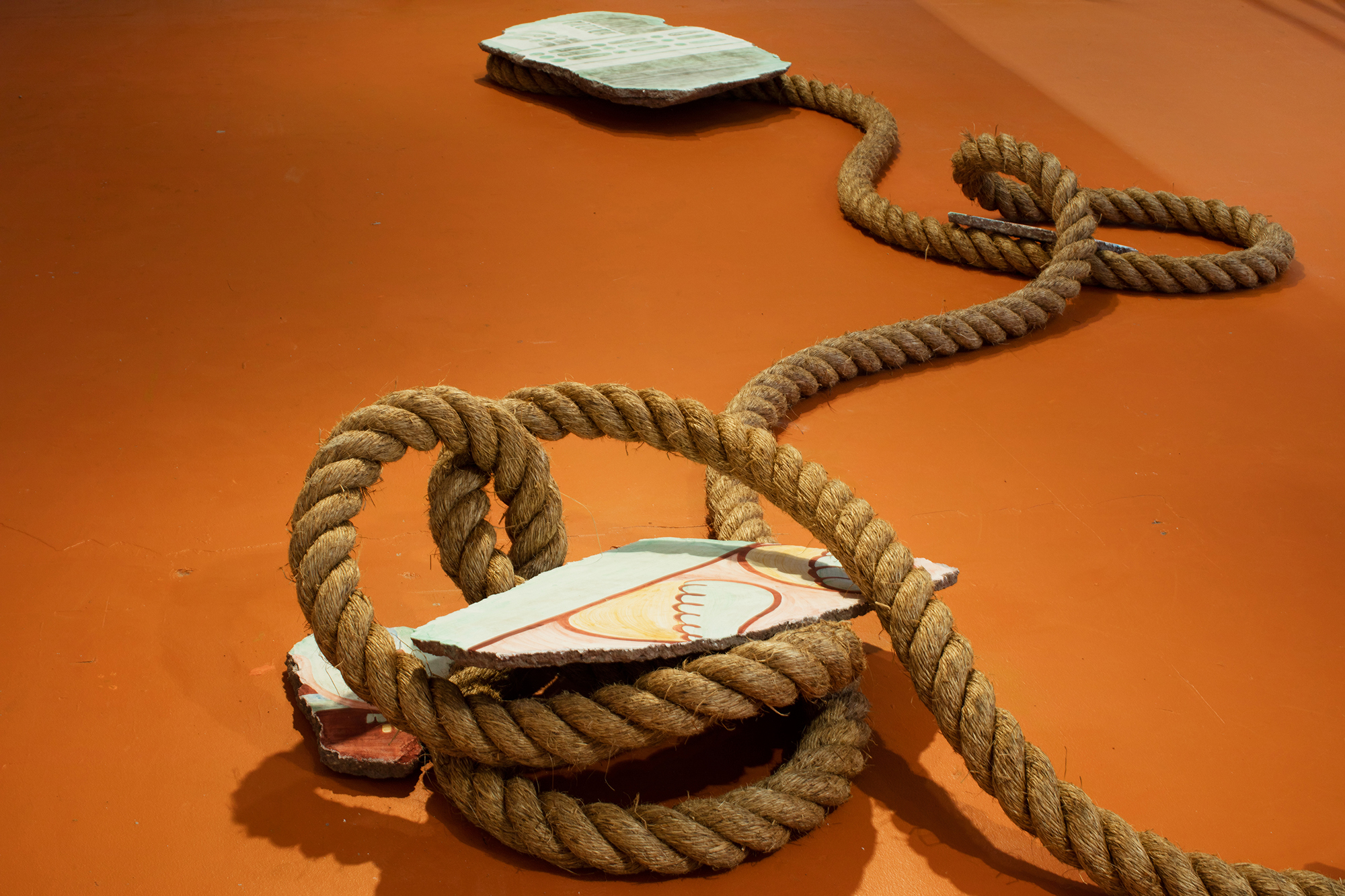
Serpent disappearances, 2015
Rope and mural fragments; concrete with wire and plaster

Feathered Changes, Serpent Disappearances, 2016
sketch, watercolour on paper
The Robin Hood Constraint
Grandmother’s biography has many loose threads. We knew that she was born in New Orleans, she eventually moved to San Francisco and then to Cuautla, where she lived in a tiny house with hundreds of cats.
One day she asked Adriana to pick up a big wooden trunk, and to not open it before she died. Adriana didn’t know what the trunk contained, but only that it had to remain sealed. Anyhow, she was very curious about the contents and could not stop gazing at it.
She longed to give in to temptation and open it, but she always re-tied the cords and returned the chest to its shelf. However, one day she untied the knots and opened it.
Inside was a collection of notebooks with short stories, poems and theater plays all written by hand. At the bottom of the box there were some documents in an envelope. It seems that she was adopted, and for years she tried to find her ancestors.
The genealogical tree was a big drawing with names connected to arrows and tiny annotations. The tree ended up in Nottingham, with a final remark that concluded that we relatives of Robin Hood. Adriana had finally found the perfect argument to justify her mastery of thievery.
Use or steal all of the words found on this paper and disguise it into your own text. Your composition can be on any topic. You may add your own as well as remove existing conjunctions, articles, and change verb tenses, but nothing else. All words that you did not manage to use in your application must be listed at the end of the text. The curator who writes the most compelling story will be awarded the fellowship.

Tree Fish Figure Kill Hole Sequence, 2016
Low-fire stoneware with mason stain

Feathered Changes, Serpent Disappearances, 2016
sketch, watercolour on paper
Feathered Changes, Serpent Disappearances
I once met a person who had an amazing
memory. He remembered everything, including
the complete repertoire of background
tunes in the supermarket. He remembered
things I could not remember about myself.
But I thought forgetting and the process of
doing so are more important than the constant
accumulation of memories. So I left.
Then I met someone else who had no memory
at all; he forgot everything very quickly.
He could not watch a film from the beginning
to the end. Reading a book was almost
an impossible task as it implied too great an
effort of connection between facts and characters
in time.
I could tell him the same story several
times, but he would not remember. I started
to experiment, making variations. It was an
expanding field of narrative. This imaginary
space was crowded with doubles, triples,
and erased beings. He could distinguish
some characters being repeated, he could
recognize some patterns. At one point he
started to be paranoid. So he left.

Detail: Feathered Changes, Serpent Disappearances, 2016
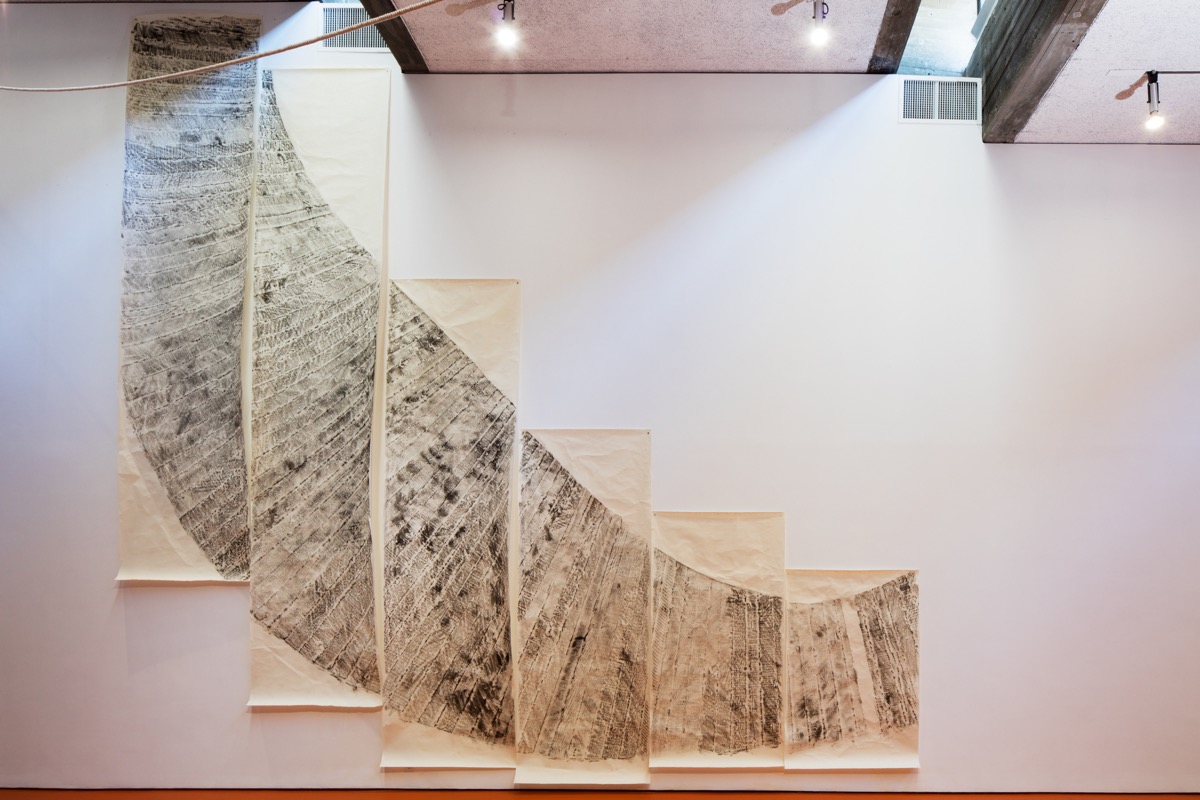
Light Canon Rubbing, 2016
Japanese paper and sumi ink

Feathered Serpent, 2016
Concrete with wire
Installation view outside at San Francisco Art Institute, Walter and McBean Galleries, San Francisco, 2016

Making of Coyote Bee Eye Kill Hole Sequence
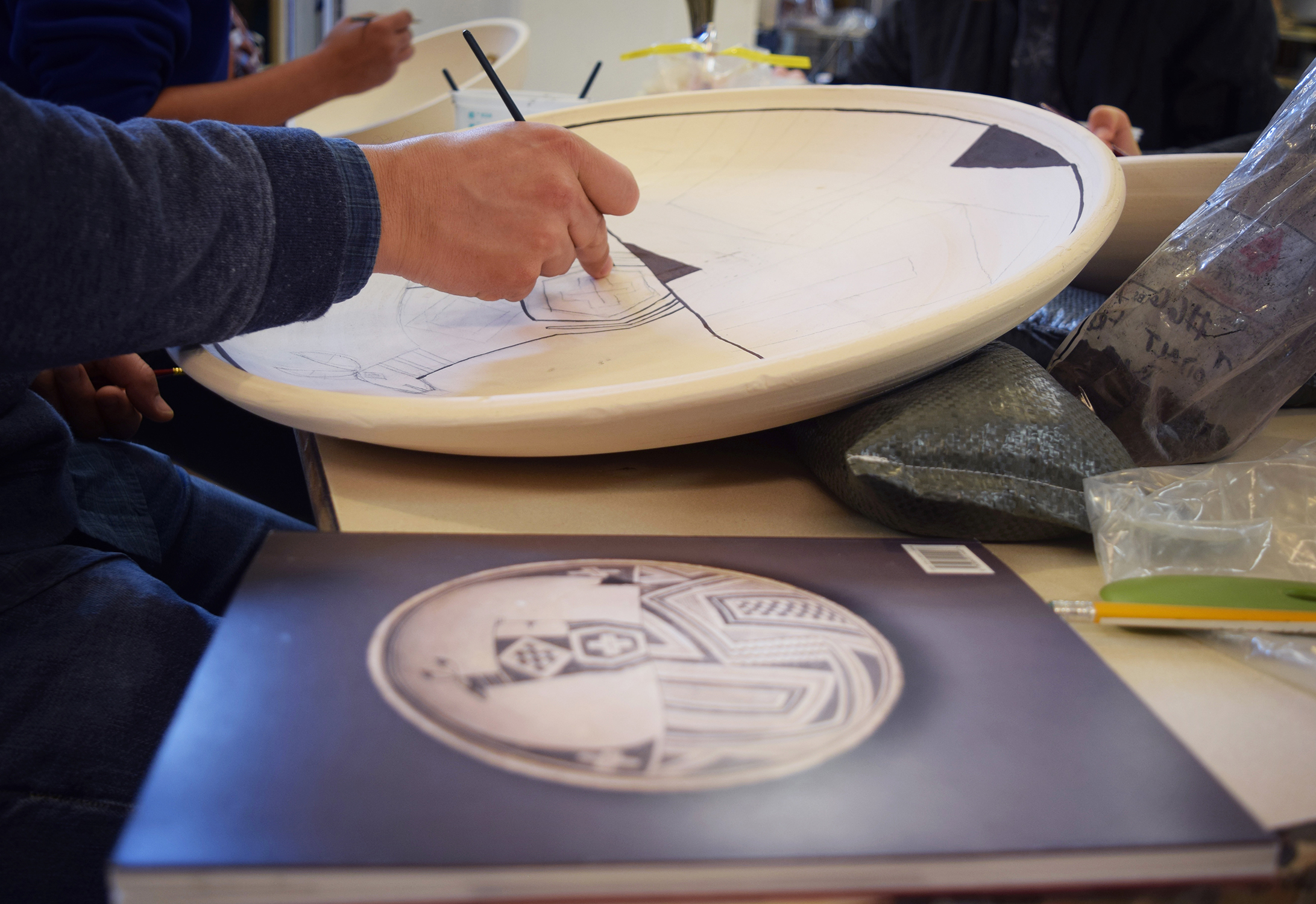
Making of Coyote Bee Eye Kill Hole Sequence

Feathered Serpent, 2016
Concrete with wire
Installation view outside at San Francisco Art Institute, Walter and McBean Galleries, San Francisco, 2016
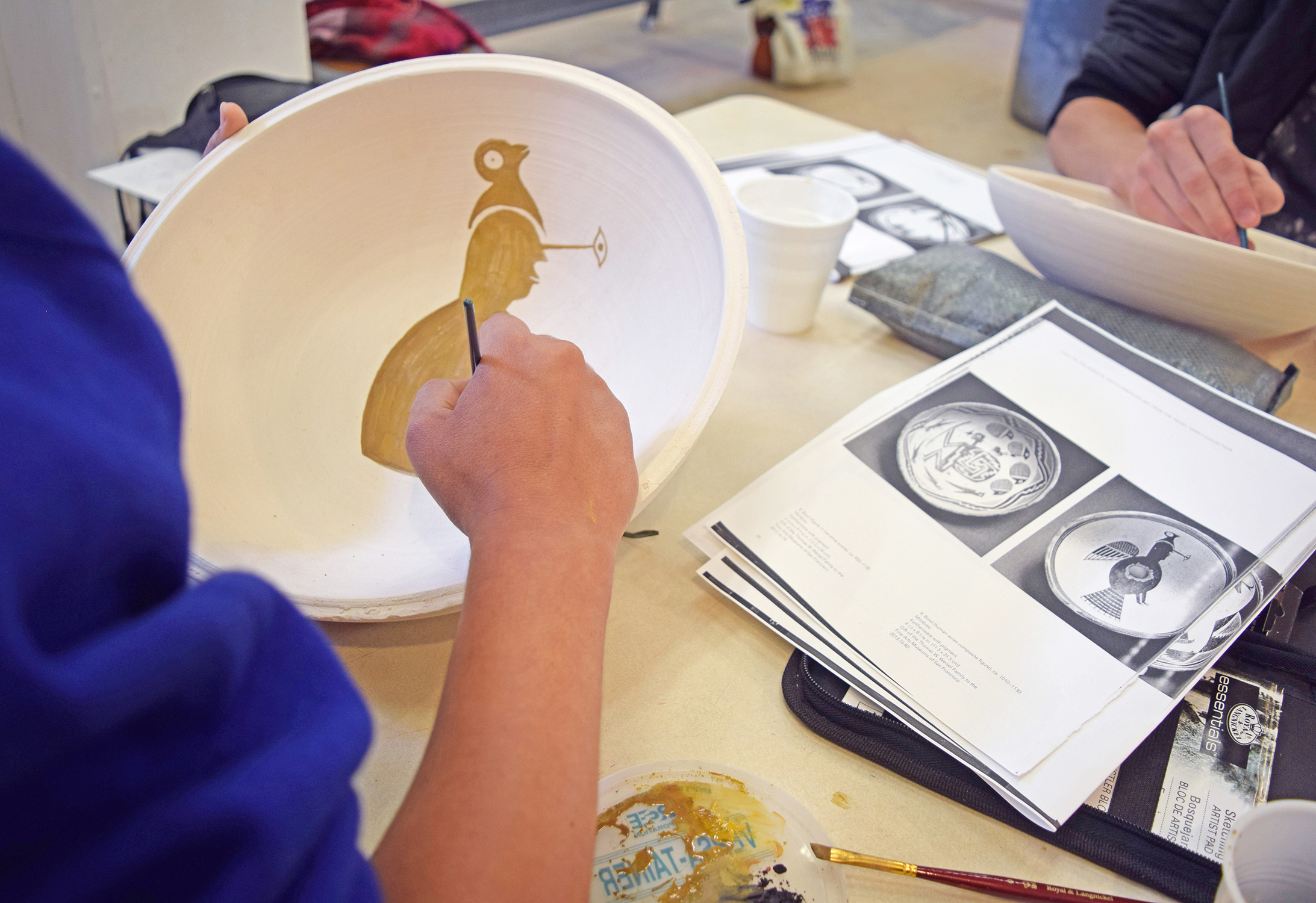
Making of Coyote Bee Eye Kill Hole Sequence
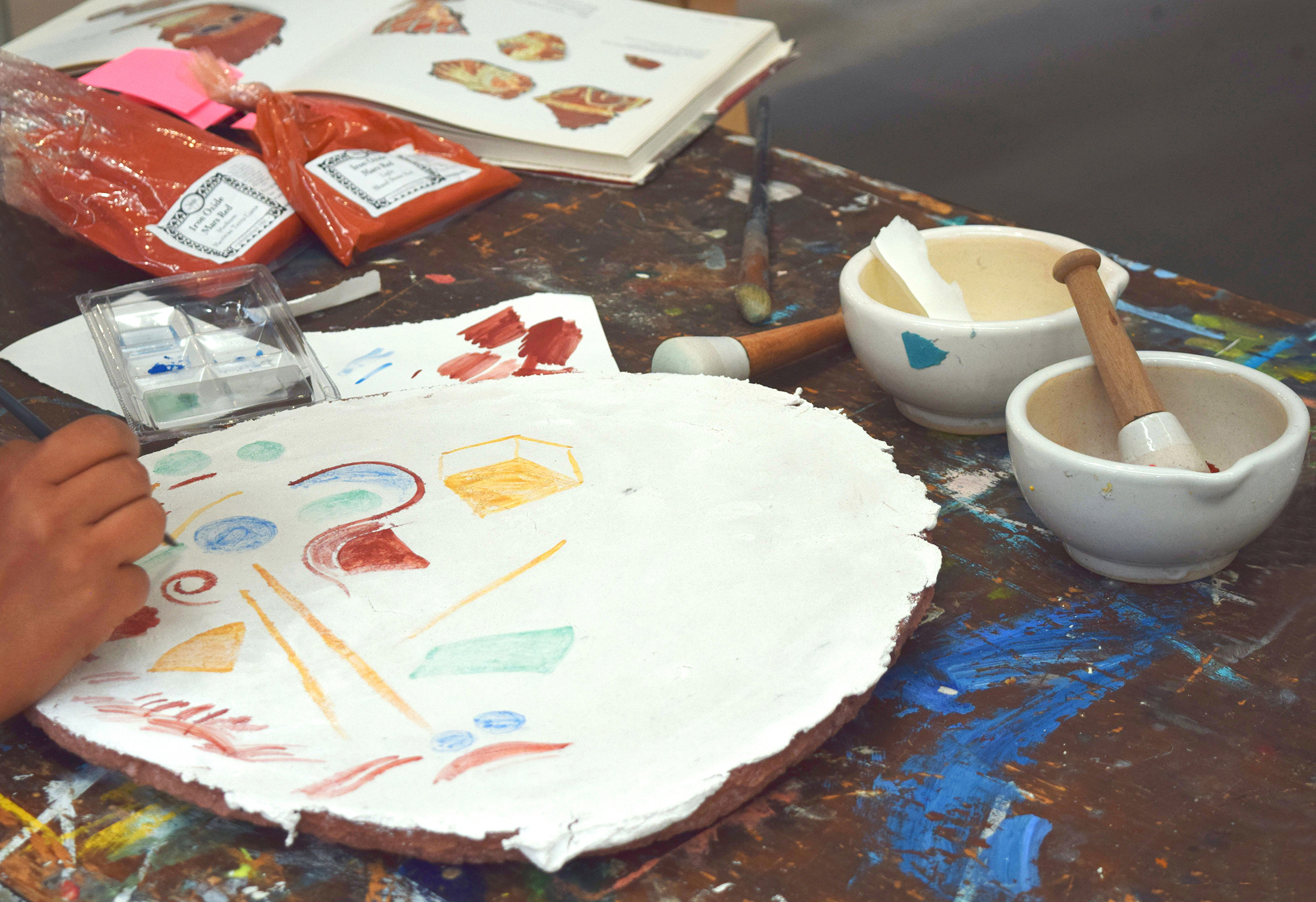
Ceramic hand painting tests

Feathered Serpent, 2016
Concrete with wire
Installation view outside at San Francisco Art Institute, Walter and McBean Galleries, San Francisco, 2016